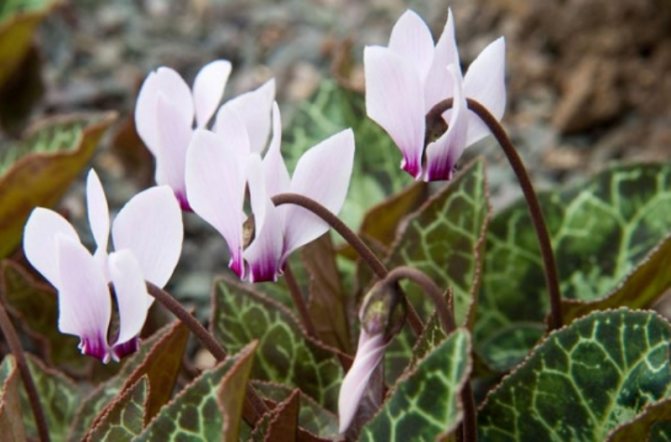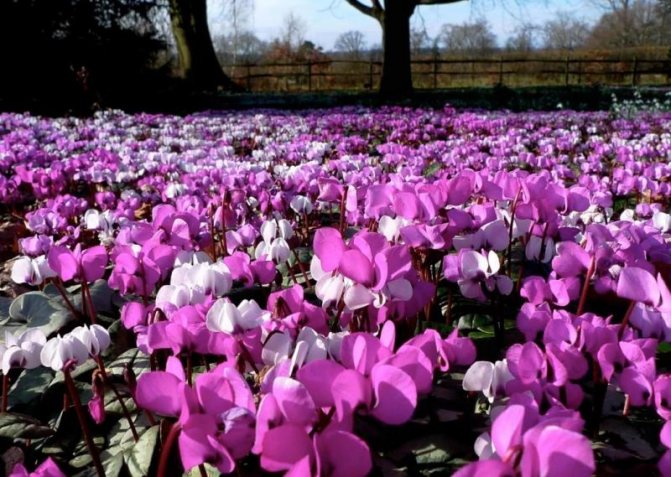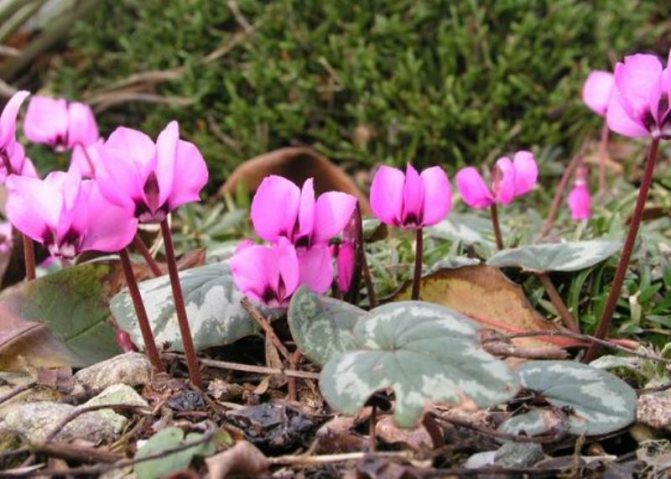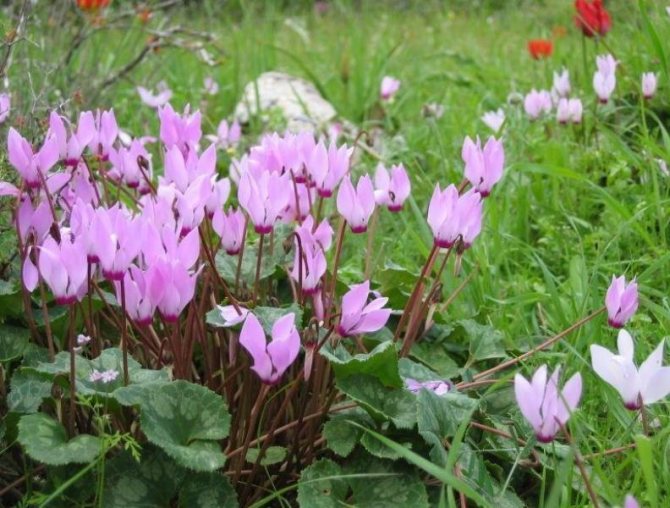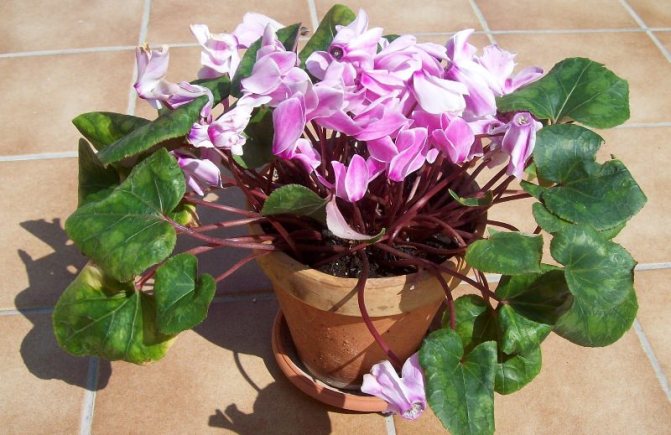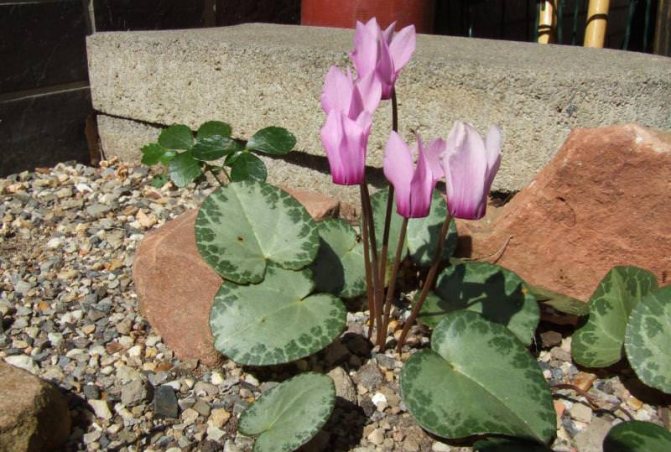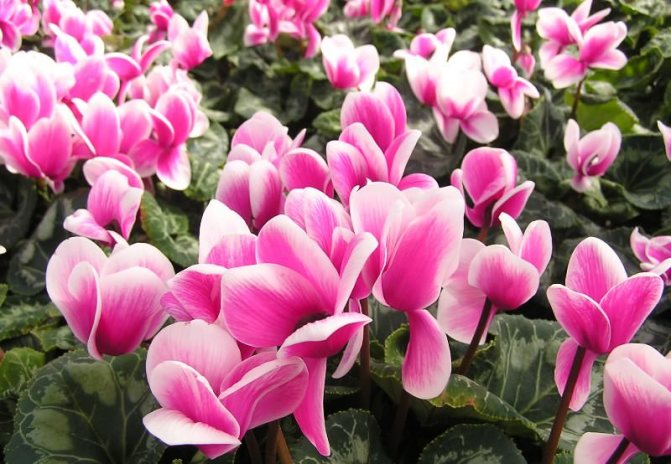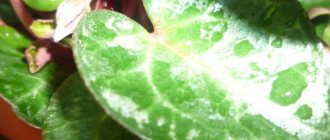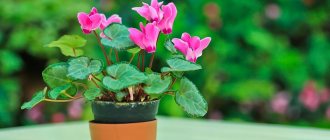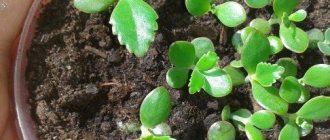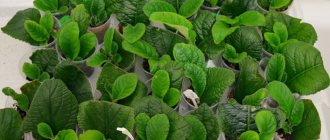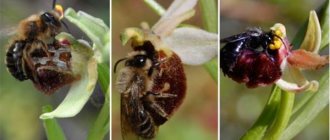- - in no case store the tubers of the faded cyclamen in the refrigerator - after such storage, the bulb will not wake up;
- the cyclamen flower does not tolerate heat and stuffiness, but it lives well in a cool room at a temperature uncomfortable for humans - only 6-12 ºC;
Read also: Trifoliate clitoria: flower description, photo, cultivation, properties of blue tea
Cyclamen growing from seeds
Cyclamen seeds are sown in February in containers filled with a moistened universal substrate. Thoroughly sprinkle them with earth, with a layer of about 1 cm. Crops are regularly watered, preventing the soil from drying out. The optimum temperature for germination of cyclamen seeds is + 18 ° C.
Seedlings appear about a month after sowing. Seedlings of cyclamen dive, when they have two leaves, in small pots with a diameter of 5-6 cm, leaving the nodules not covered by 1/3. They are planted in a permanent place by the end of May. Plants will bloom only for 2 years, when their tuber gains the required mass.
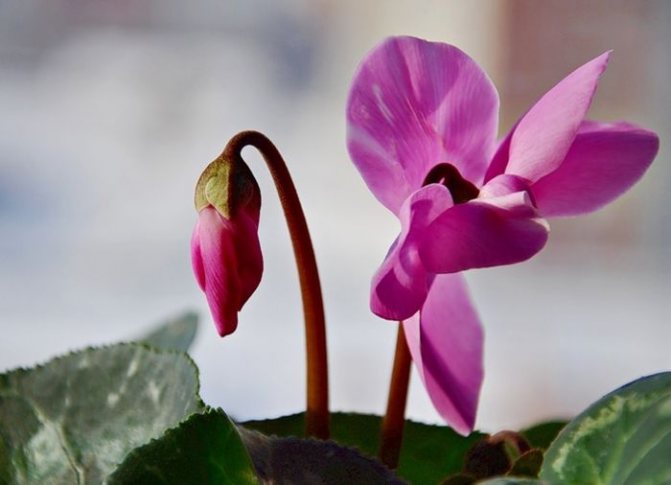
Cyclamen transplant
How to transplant cyclamen.
The cyclamen is transplanted into a new substrate about once every two years if the pot has become too small on the bulb. This should be done at the end of the dormant period before the start of the active growing season.
But remember that cyclamen does not need a spacious pot, it blooms well only in close quarters, when the layer of earth from the bulb to the wall of the pot is no thicker than 2-3 cm.For example, for a bulb 1-1.5 years old, a pot with a diameter of 7-8 cm is suitable , and for a two-three-year-old bulb - with a diameter of 14-15 cm.
In a new pot, put expanded clay for drainage, a layer of fresh substrate, then an onion along with an earthen clod and roots and add the substrate so that the tuber is immersed in it by two-thirds. Tamp the soil well. The transplanted cyclamen will need fertilizers no earlier than in a month.
Cyclamen transplant after purchase.
A cyclamen is transplanted after purchase only if it is in a dormant period, which is strange in itself - well, who buys an onion buried in the soil? If you bought a flowering cyclamen, wait for it to bloom and rest, and then, at the very beginning of the growing season, if the bulb is cramped or you want to change the technical plastic pot to a beautiful one, transplant the cyclamen in the described way. Or, if the plant does well in an old pot, it is better to put an ugly cyclamen pot in a beautiful planter.
Read also: Decorative honeysuckle: planting and care
Caring for a "sleeping" plant
As we have already said, the flower spends most of the year in hibernation.Cyclamen goes through a dormant period, as a rule, well. There is practically no need to care for it, it is enough to water it occasionally, preventing the topsoil from drying out. Indoor cyclamens can be moved to a cool, dark place with humid air.
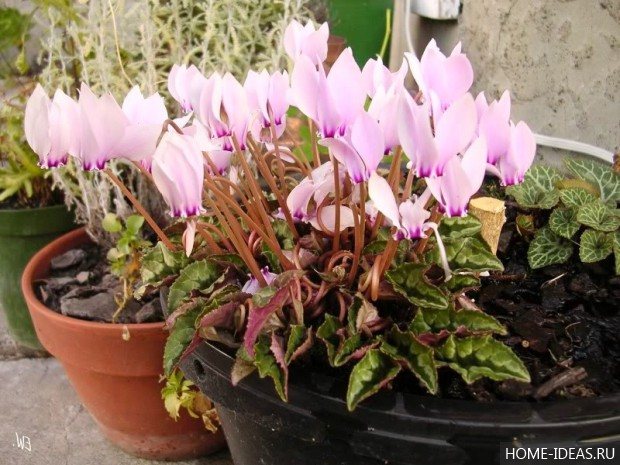

For garden varieties, the wintering period is very important. However, it is not required to specially insulate the cyclamens. If they grow under your trees, then a layer of fallen leaves will be enough. Under such a dense natural blanket, handsome men will perfectly wait out the cold.
Cyclamen: photo
Varietal variety of the plant
In the natural environment, cyclamen has become a rare plant. He confidently moves closer to human civilization, becomes a home. Their natural habitat is a territory with a humid climate - the Mediterranean, Crimea, Caucasus. According to various sources, there are from two dozen to fifty types of cyclamen. The most common and appreciated by gardeners are two varieties.
1. Persian cyclamen
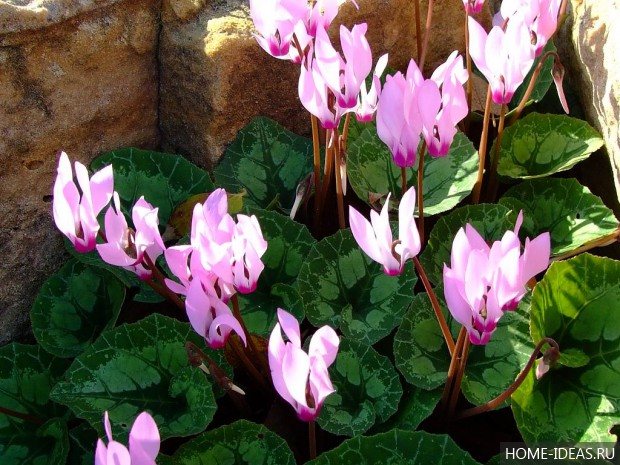

This perennial reaches a height of 30 cm. The variety of colors simply enchants - white, pink, lilac, lilac ... Some varieties smell very strong, one might even say harshly. But all the same, this aroma of variegated flowers is pleasant, gently spilling over the garden. Please note that the home flower of Persian cyclamen requires careful handling. Damage to the growth point located on the tuber can lead to its death.
2. European cyclamen (ivy, Neapolitan)


This is an evergreen plant, the birthplace of which is the Crimea and southern European countries. Its delicate lilac flowers are smaller in comparison with relatives of other species. Kidney-shaped roots are located on the surface of the European cyclamen, with the help of which it easily multiplies.
I would like to give examples of the most popular varieties of garden and home cyclamens:
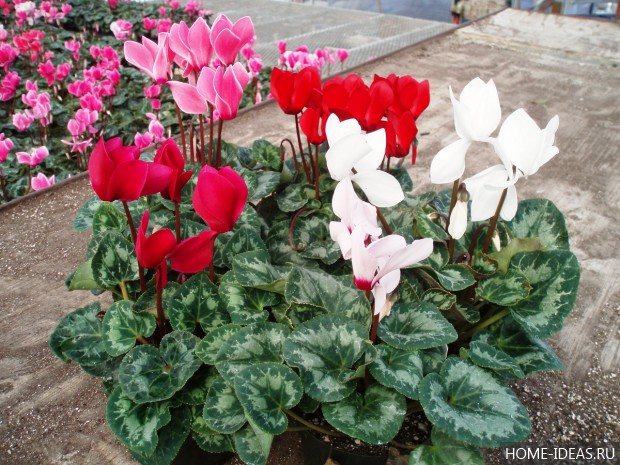

"Scarlet Moth" - the flowers have a bright scarlet color,
"Spring moth" - early pink variety,
"Victoria" - large flowers with velvet edging,
"Darts Salmon" is the earliest, most unpretentious variety to care for,
"Vit" - large white flowers.
Cyclamen: flower description
Cyclamen is a perennial tuberous plant that belongs to the Primroses family (subfamily Mirsinovye). In the wild, the flowering plant is common in southern Europe, along the Mediterranean and Black Sea coasts, and can also be found in the Caucasus. There are more than 60 species of wild-growing cyclamens, and only about 20 of them are grown as indoor crops.
The name of the flower "cyclamen" comes from the Greek "kyklas", which means "round". This is due to the shape of the tubers of the plant, which have a rounded, slightly flat shape. The diameter of the tuber reaches 15 cm. The flower itself in its structure resembles bright fluttering butterflies, towering over rich green leaves, on thin but strong peduncles. The color scheme of cyclamen is admirable. Delicate butterfly flowers can be bright pink, pale purple, lilac, snow-white, burgundy or purple. The height of the peduncle is up to 30 cm, there are dwarf varieties that reach no more than 12 cm in height.
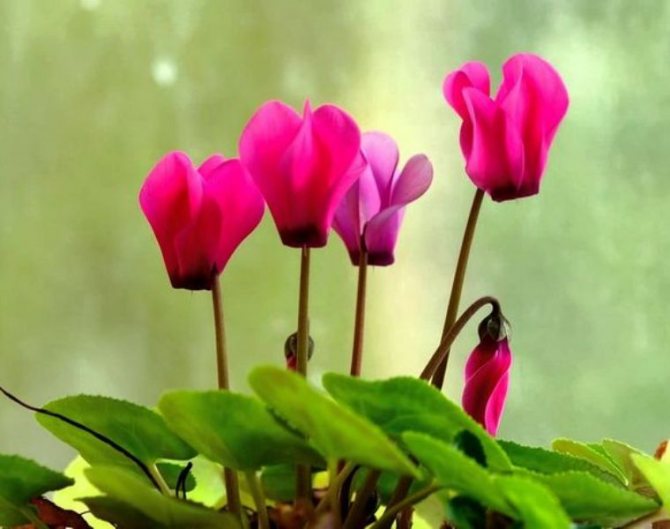

The leaves in the shape of hearts, collected in a root rosette, give a special charm and decorative effect to the plant. The leaves are colored deep green, sometimes there are specimens with silvery streaks. In addition to its decorative qualities, cyclamen is a useful medicinal plant. Cyclamen drops are an effective remedy in the treatment of sinusitis and other diseases of the nasal cavity.
Cyclamen diseases and pests
Most of the problems associated with growing cyclamen (leaf rot, ovary dropping, etc.) can be avoided by properly caring for the plant. If your cyclamen leaves are shredded and deformed, a cyclamen mite may be the cause.To overcome the pest, you need to wash the leaves of the plant with insecticidal soap for 5 days, and then spray them with a special insecticidal preparation "Agravertin". By the way, the same processing method will help you cope with aphids, which also very much like to settle on cyclamens.
Reproduction of Cyclamens
Seeds
The seedling method is used. There are types of cyclamen, for example, "Persian", which reproduce only by seeds. Children are not formed on their corms.
Daughter corms
Other types of cyclamen grow daughter roots on the tuber, which can be used for propagation. To divide the tubers, already adult specimens with grown children are needed. They are separated and disinfected with charcoal. Then they are placed in the ground. After that, the first two weeks are very rarely watered.
> Ideal landing site in the country


If you decide to decorate a summer cottage with this plant, be responsible for choosing a place for planting. It should be noted that animals are not indifferent to him. For example, pigs are very fond of feasting on drywall tubers, including Vietnamese piglets, which many today keep in their backyards.
Piggies can ruin all the beauty of your flower garden, tearing it up with their little spots in search of delicious roots. But for rabbits, chickens and other domestic animals, the plant can be dangerous. The conclusion follows from this: it is better to grow cyclamen in the country in places where access to which is limited for animals. This variegated flower loves the sun's rays, but is afraid of drafts. Better to plant it under the branchy crowns of fruit trees.
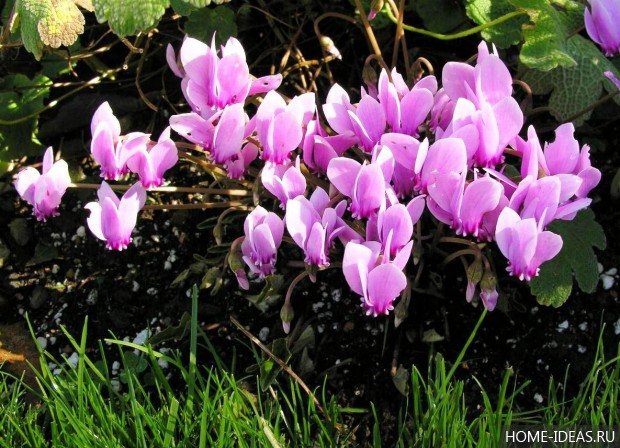

They will give the plant shade on a sultry day, protect it from the wind and cover it with a blanket of fallen leaves. The dryak fits perfectly into the palette of an alpine slide. Probably, it is not for nothing that the Germans call this flower an alpine violet.
Growing features
To grow cyclamen from seeds at home, you need to know some of the features of this process.:
- Seedlings will appear in about 30 days, but only if the air temperature during germination is +15 degrees. If this figure is exceeded by several degrees, then the seeds can wake up for up to three months.
- By using several types of plant seeds, you can create a luxurious flower garden from healthy plants on your windowsill.
- You can sow seeds throughout the year, but for better crop growth, it is better to adhere to the biological rhythms of the plant, and sow in spring or late summer.
- Seed cyclamen is best grown in a dark room.
Types and varieties of cyclamen


The genus cyclamen, according to some sources, has 20 species, and according to others - as many as 55, where it is true, I could not figure it out. I only know that these extraordinary plants are widespread mainly on the shores of the Caspian, Black and Mediterranean seas. True, in Central Russia, cyclamens from the Crimea, the Caucasus and Central Europe are mainly grown. Most often, European cyclamen is grown in open ground, less often Persian.
Cyclamen persian
Persian cyclamen, whose homeland is Iran and the Mediterranean countries, is a perennial tuber-root herbaceous plant, reaching a height of 30 cm.Its basal leathery leaves are dark green in color. There is only one growth point on the tuber of Persian cyclamen, damage to which will lead to the death of the plant. The flowers of Persian cyclamen are different in color: white, pink, crimson, purple, purple and even burgundy. Some varieties of Persian cyclamen are distinguished by a sharp and even slightly intrusive, but very pleasant smell. Flowers, as I said, can be pink, crimson, white, lilac.
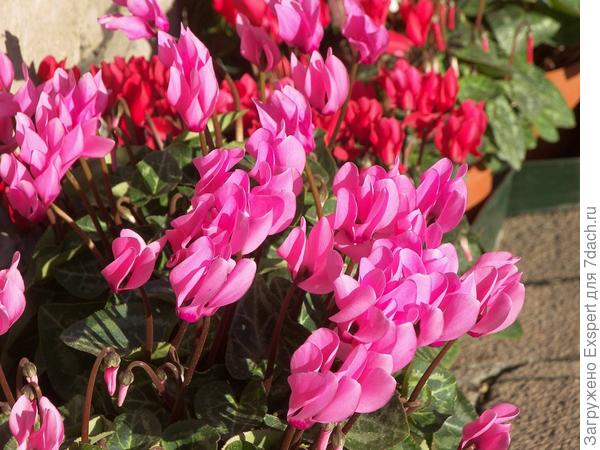

Decorating your home - cyclamen: how to grow from seeds?
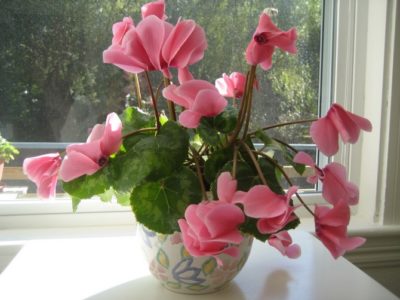

Cyclamen is a beautiful indoor flower that strikes with graceful, delicate buds.In nature, there are more than 15 species of this plant.
Basically, they are all wild, only two species are grown as indoor plants: European cyclamen, blooms in spring-summer, Persian cyclamen - blooms in winter. Consider how to properly carry out the plant's agricultural technology so that the flower blooms.
Rules for choosing a strong plant
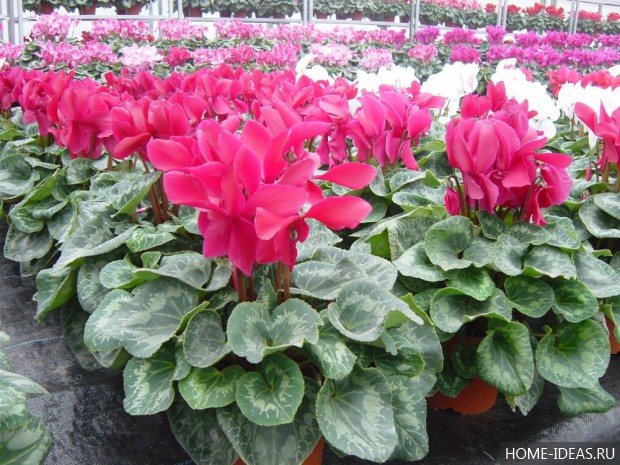

When buying for planting both garden and decorative dryak, pay attention first of all to the tubers. They shouldn't look wrinkled. Also do not take those roots on which there is even the slightest sign of rotting. Next, we look at the leaves. In a healthy plant, they will be dense, shiny, juicy. With lesions, flaccid, dried out at the edges - these are the characteristics of the leaves of a sick or weakened cyclamen.
Sowing preparation


The flower loves light and nutritious soil. It can be found in the store, where soil mixture is sold specifically for this crop. But if there is none, you can buy soil for Saintpaulia.
But if you prefer to do everything yourself, then you can prepare the soil by mixing in equal proportions:
As soon as the soil is prepared, you can start preparing the seed material.otherwise they will wake up for a very long time:
- Soak the seeds for 18 hours in any growth stimulator, for this you can apply - Etamon, Zircon, Epi-extra. The drug is sold in flower shops, and it should be diluted strictly according to the instructions.
- Sometimes the seeds are soaked in manganese-sour potassium - the solution should be weak, or just in warm water. The seeds are soaked for 14 hours.
- If you plan to breed cyclamens, then at the stage of seed preparation, divide them into several groups and apply different processing methods. Subsequently, you can choose the best option for yourself.
Choosing the right pot
The development and flowering of cyclamen directly depends on the chosen pot in which the plant will grow. The pots should be washed small, relative to the tuber itself, that is, the distance between the walls of the pot and the bulb should be no more than 3 cm.Cyclamen is capable of flowering only in very close conditions.
Soil requirements
The soil must meet the requirements of the plant - light, nutritious, loose... Often they buy it in a store, since in a city it is difficult to prepare a soil mixture on your own.
Cyclamen - medicine and garden decoration
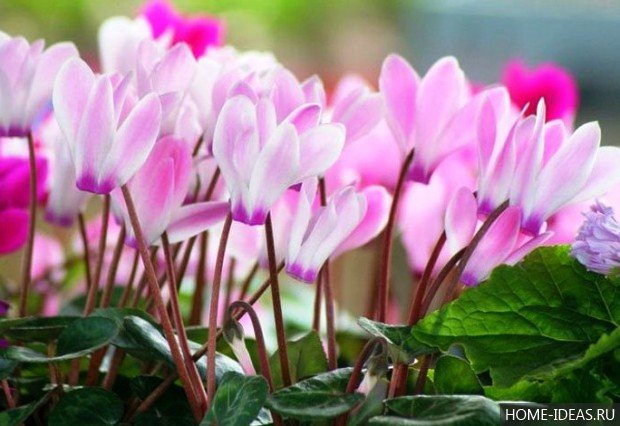

Cyclamen is an unusual flower. It pleases us with its flowering at a time when there are already too few bright colors in the surrounding landscape. In the garden, it blooms at the end of summer, when all its neighbors have logically completed their seasonal life cycle long ago. Against the background of yellow leaves, this picture looks very impressive - bright flowers on a gold carpet.
On the windowsill, the home flower cyclamen "sleeps" for almost a year. In the kingdom of flora, it will probably be difficult to find a worthy rival to compete with this plant in laziness. Cyclamen accumulates strength for 9 months, concentrating its life in powerful tubers. And only in winter he wakes up to please the grower.
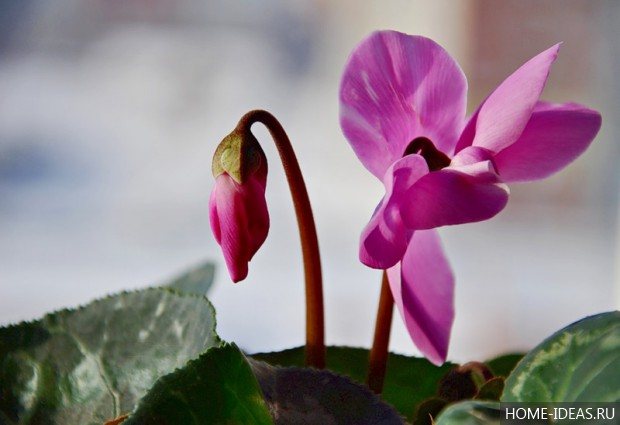

The tuber of this plant has an almost perfect geometric shape - round. Noticing this feature, the ancient Greeks called it cyclamen - from the word "cyclos", which means "circle". And our ancestors called the plant dryak, borrowing this name from the Polish language (literally translated as "a remedy for animal poison"). By the way, the medicinal properties of cyclamen are known today. The plant extract is used in modern medicine to treat sinusitis.


As we said, cyclamen tubers are the heart of the plant. They are large, juicy, with a rich starch content. Every year the root system develops more and more. People noticed that in the forests wild boars tore these nutritious round roots out of the ground, for which the cyclamen was popularly called "pork bread".
How can the seed be collected?
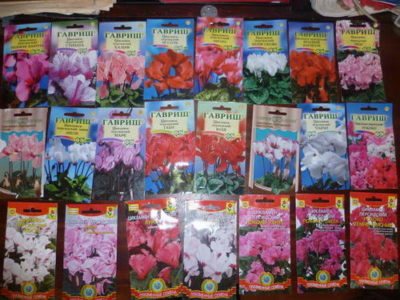

Many people choose the easiest way to propagate cyclamen - they buy seeds in the store. But if there is already a flowering plant at home, then you can collect seeds from it.
The flower will not have seeds until it goes through the pollination procedure.... The cyclamen itself cannot do this, so you need to start collecting pollen, then arm yourself with a brush and cross-pollinate. This is a creative process, because if you take two plants of different colors for pollination, you get a new, attractive hybrid, with an original color.
The period of natural flowering of cyclamen is from December to February, at this time pollination is carried out. This process is best done on a sunny morning. Pollen can be collected by gently tapping on the flower, pollen will begin to pour out of it, which must be placed on the pistil of a neighboring plant.
You can also use a brush to collect pollen and spread the middle of another flower.... For complete confidence, you need to do this at least 5-7 times. If pollination is successful, the flowering process quickly stops, and a small, round box is formed in place of the flower, in which small, round, light brown seeds ripen. The box cannot be removed from the plant, the seeds will ripen from 90 to 140 days. The plant at this time needs to provide a comfortable temperature - +20 during the day, +12 degrees at night.
Read also: Proper planting and caring for rosemary in the garden
What to expect from homemade cyclamen seeds? Such seeds do not lose their ability to germinate for a long time - 3 years. It is worth noting an interesting fact that if you let the seeds lie down for a year and a half, then the plant from these seeds will bloom much faster.
View selection rules
Not all types of cyclamen can be planted in open ground. In home gardening, the most unpretentious species and varieties are most often used, which have sufficient frost resistance and are able to withstand quite easily significant drops in air temperature. An ornamental plant does not require a significant amount of lighting, so cyclamens can be grown in shady areas. A flowering crop is often planted under garden plantings, including ornamental shrubs and trees.
We also recommend reading:
The most frost-resistant is considered to be European cyclamen, or alpine violet. This species blooms in summer and is distinguished by its small, pink flowers with a fairly strong lily of the valley aroma. There is a purple coloration on the underside of the leaves, so many amateur flower growers know the species as cyclamen purple.
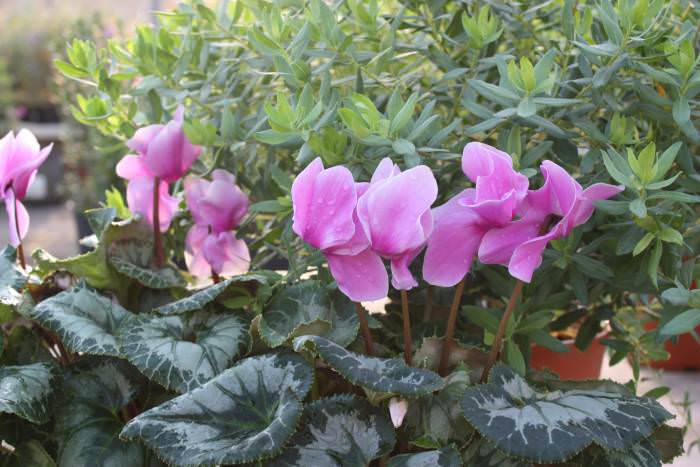

In the open field, you can also plant the Neapolitan cyclamen, or ivy-leaved cyclamen, which blooms in the autumn. The species forms pink, white or red flowers and has very decorative foliage with a marbled light green pattern.
The least frost-resistant is the highly decorative Kosky cyclamen. The garden culture has very beautiful rounded leaves, on the surface of which there is a silvery pattern. Flowering in early spring, characteristic of the species white, pinkish or bright enough, red flowers.
Fire flower buzulnik: types and rules for growing on the site
Choosing a place in the room
Like any other plant, Kosky cyclamen requires some attention, and when kept at home, it is important to take into account several basic parameters: lighting, temperature, air humidity and soil composition.
Lighting
Despite the fact that koskiy cyclamen is a fairly light-loving plant, direct sunlight on its leaves threatens to burn them.
Light-loving indoor plants also include: monstera, Kalanchoe, dracaena, anthurium, dendrobium, gloxinia, begonia.
Therefore, window sills from the west or east side of the house are best suited for its placement. In case of emergency, you can place the pots with the plant on the southern windows, only in this case you will have to obscure them.
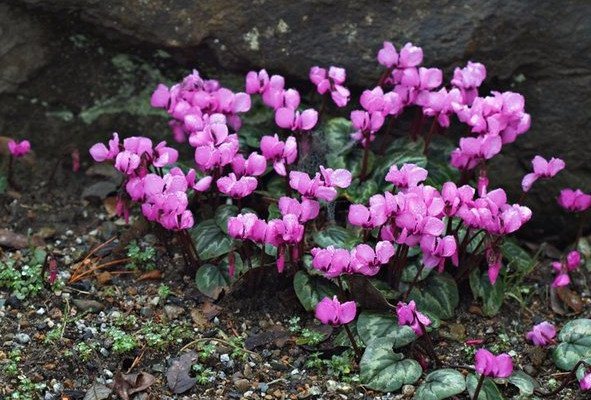

Temperature characteristics and air humidity
When growing kosky cyclamen in your home, it is important to provide it with an optimal temperature regime. In winter, the temperature can be reduced to + 11 ... + 14 ° C, but in summer it will be better if the temperature indicators are kept at + 18 ... + 25 ° C. The most comfortable values for sufficient plant growth and flowering are + 11 ... + 14 ° C.
Until the very formation of the buds, cyclamen must be regularly sprayed, but as soon as they appear, this procedure is stopped, otherwise their decay is possible. Water can also be added to the sump, but only if it is filled with peat, expanded clay or pebbles.
Growing substrate
The composition of the potting soil also plays an important role in the successful cultivation of a flower. Therefore, in order to obtain timely and abundant flowering, it is so important to prepare the right substrate.
The ideal option would be a mixture of leaf and turf soil (in equal proportions) with the addition of crushed lime, crushed limestone or old plaster. Also, one should not forget about drainage, since plants often suffer from even a slight excess of moisture.
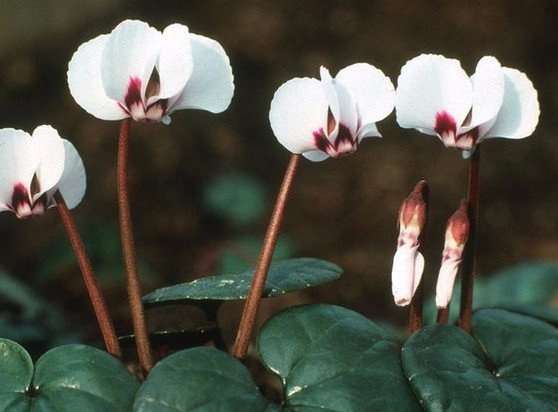

Landing in open ground
The ideal soil for colorful flower butterflies is humus with a lime content. The plant is very demanding on the soil, therefore, when planting, you need to create favorable conditions for it. It is not at all difficult to make a special soil mixture. It is necessary to take in equal parts sod and leafy soil, add limestone crushed stone.
The flower loves moisture, but suffers greatly from waterlogging. It is lime that will become the necessary drainage, which will regulate the portions of water flow to the tubers. When planting a decorative duck in open ground, it is necessary to completely bury the tuber in the ground in order to protect it in a cold season.
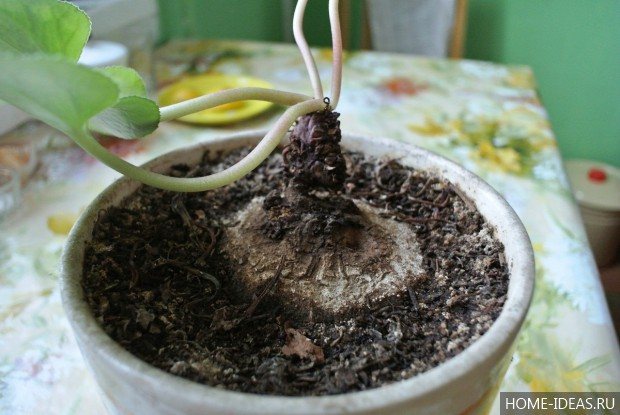

Regardless of the species in the flowerbed, you need to dig a hole about 10 cm deep. As for the seasonal framework, the reproduction of cyclamen by dividing the tuber is best done in the fall, before flowering. The flower does not like a change of residence, he does not like transplants. In one flowerbed, it can grow for a decade, and this will only become more magnificent.
Flower propagation methods at home
Cyclamen reproduces in many ways. But you need to choose the most optimal one based on the type of plant. So:
- By dividing the tuber - an option for both types of plants, but you need to take only adult crops.
- Sowing seeds - can be used for growing any kind, even ivy.
- Outlets - this method is applicable only for the European species, since the shoots of the Persian cyclamen do not take root well.
- Tuber daughters - an excellent option for breeding a European flower, only in this species small children appear around the main tuber. When transplanting, they are effortlessly detached and placed in a separate pot.
Photo selection
Growing and care
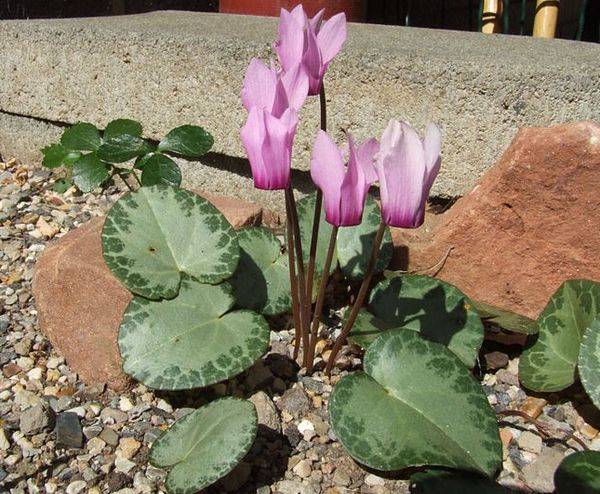

Even knowing how to care for cyclamen, difficulties can not be avoided. This is because he reacts very painfully to any changes in the conditions of detention. What are the most common problems?
It all depends on the period: on the eve of summer, this is a regular phase of preparation for sleep, during which part of the leaves, or all the foliage, can die off (see above). If leaf fall began in an active season for the plant, the reason should be sought in the inadequacy of the conditions of care. Most often, this is due to the too high temperature, which the cyclamen flower perceives as the onset of the hot season.
Leaves can lose their natural color from a lack of light, which is typical for winter in the middle lane. Do not forget about the importance of lighting and feeding at the beginning of the growing season!
- If the leaves of the cyclamen wrinkle and dry out ...
Alpine violet does not like stuffy rooms, it needs air circulation, as well as moderate humidity. This helps to strengthen the immune system, prevents attacks from pests. Dry spots may be leaf burns from bright sunlight. Although the plant needs a lot of sun, direct rays should not hit the foliage. Excess fertilizer also "burns" the root system, and accordingly is reflected on the leaves.
- If the new leaves of the cyclamen grow small ...
A possible reason is the lack of nutrition and lighting that the plant needs with the arrival of autumn. For the same reason, the buds can be small, or fall off before they have time to open. Organize regular feeding and choose a well-lit location (see above).
- If the leaves of the cyclamen have brown spots ...
First of all, it is worth suspecting excess moisture, which is extremely dangerous for the plant. Systematic overflow leads to rotting of tubers, this is immediately reflected in the foliage, which becomes covered with brown spots and withers rapidly. It is not easy to save a flooded plant, for this it is necessary to remove rotten parts, dry it, replace the substrate, and adjust the watering regime. But there is no guarantee that after such executions it will come to life! Therefore, it is better not to bring the soil to the "flood" and "drought".
Any spots on the leaves (especially multiple ones), strokes, dots, plaque are signs of a disease or pest activity. If you did not find the answer to your question, visit the pages: online pest diagnostics, online diagnostics of diseases.
Now you have learned the cyclamen flower and home care, so you can easily grow it.
flowery-
Since cyclamens are forest dwellers, they should take their place under the canopy of trees and shrubs, where they will be comfortable at any time of the year. Moreover, in the fall, fallen leaves will serve as a natural shelter. In early spring, cyclamens themselves will break through it. The soil should be loose, always with good drainage, rich in nutrients - like in a forest, where deciduous litter underneath the trees year after year, enriching the land.
Cyclamen Kuznetsova blooms in spring, purple in summer, Neapolitan in autumn. Based on the timing of flowering, you can grow a whole clearing of "alpine butterflies", which will bloom until winter. Cyclamen care is the simplest - in the summer, watering as the soil dries up, feeding a couple of times per season with potassium-phosphorus fertilizers. If the duck grows away from trees, for the winter, plantings should be mulched with fallen leaves, with a layer of up to 10 cm. In the spring, the shelter must be removed.
When buying planting material in a store or in the market, be sure to ask about its origin. For example, tubers of Dutch selection are unlikely to take root in our climate. It is best to purchase local planting material adapted to your region.
Pests
If withered flowers and yellowed leaves appear on the plant, they must be carefully "unscrewed", avoiding damage to the growth zone.
A cyclamen mite can harm the flower. If you notice that your pet's leaves are shredded and deformed, look for a pest on it and treat the plant with an insecticide.
Aphids can also settle on cyclamens. The methods of dealing with it are the same as with other pests - suitable insecticides.
If you do all this with love and care, your flowers will be healthy and beautiful.
Good luck and good luck!
Hope was with you.
General information
Cyclamen is a genus of the Myrsinoideae family. These are perennial, tuberous, herbaceous plants. With heart-shaped leaves that can have a silvery hue. The color of the flowers is varied: white, lilac, lilac, pink, burgundy. There are about 20 species in the genus.The plant extract is also used for medicinal purposes. But cyclamens are poisonous especially to some animals and therefore require careful handling.
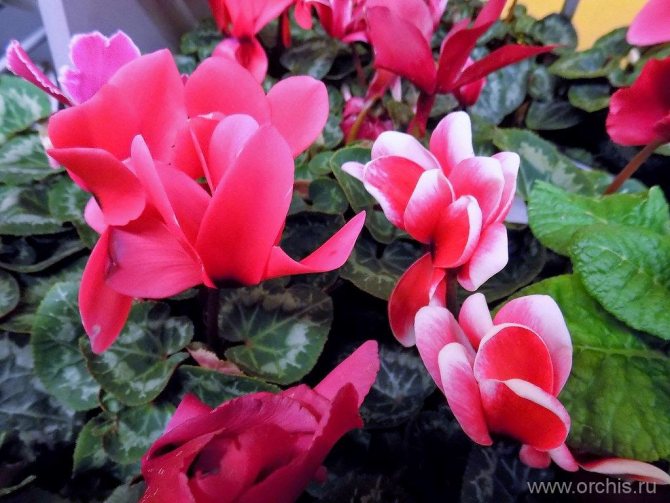

Growing conditions
It is because of the aroma and medicinal properties that they try to grow forest cyclamen in a garden or at home. There are several ways to purchase seed: buying seeds or tubers, but these will already be cultivars. If you are lucky, and the garden plot is located near the place where the flower grows, then perhaps over time it will move to your territory.
The fourth option is to go in search of a handsome man in the forest. Given that cyclamen loves to grow in the shade of trees and shrubs, on the slopes, then you need to look for them there.
But it is strictly forbidden to dig up these plants. It would be possible to turn out a couple of leaves, but in this way only the European species reproduces. The option of collecting seeds remains. How and when this can be done is described below.
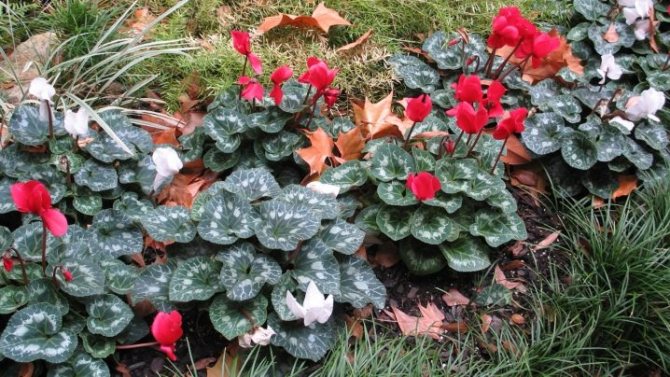

To make the plants comfortable in the garden, they are planted in the shade of trees and shrubs. In the fall, foliage will become a covering material. In order for the garden to delight with flowers from early spring to late autumn, you can plant several types of forest beauties: Caucasian, Colchis, Neapolitan. If the flower garden is far from the trees, then for the winter it is mulched with a 10-centimeter layer of fallen leaves.
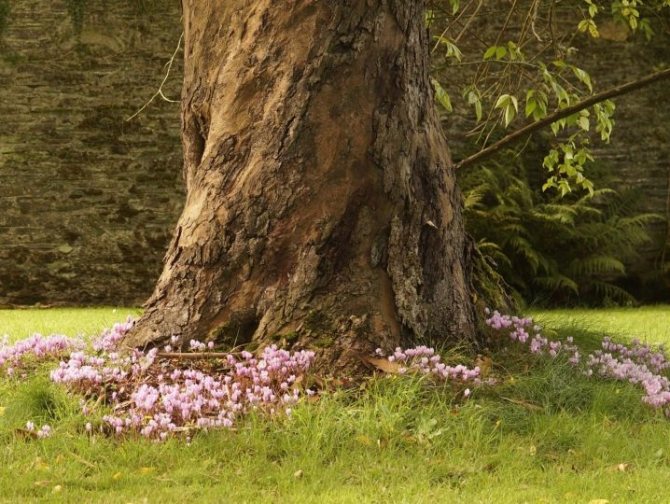

Cyclamen forest: description and cultivation


In the spring we are all waiting for the awakening of nature, when the snow begins to melt in the garden and the first blades of grass appear. And in the forest, this is the time of the appearance of the first flowers: snowdrops, Siberian spines and other beautiful messengers of spring. It was among them that a modest forest cyclamen hid, trying to escape.
This variety, unfortunately, has medicinal properties and is actively used in the manufacture of various drugs. And the beauty of flowers provoked their active cutting and sale in bouquets. The unique aroma has led to the fact that wild flowers began to be dug up and transplanted into their gardens and homes. The result was not long in coming - several types of cyclamen are already listed in the Red Book. So is it possible to grow this spring tenderness at home without destroying the flowers in nature - let's try to understand.
Transplanting flowers
It is necessary to get the cyclamen from the old form or from the flower bed, remove the small roots and old soil. You need to preserve the main part of the roots of the cyclamen - this will help it better take root in a new place. A prerequisite for transplanting is the presence of drainage for flowers. Place a small layer of soil on top of the drain, but do not compact it. Now you can water the soil, and then cover the flower so that a third of the tuber remains in the air. Leave the plant in the shade and after a while, new leaves will appear on it.
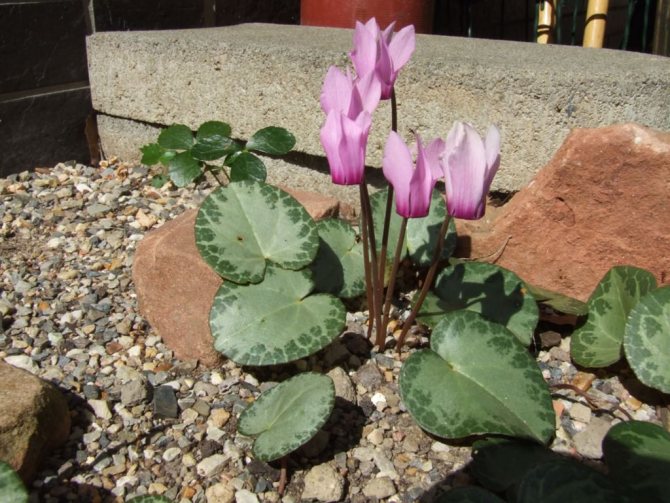

The many-sided Greek cyclamen
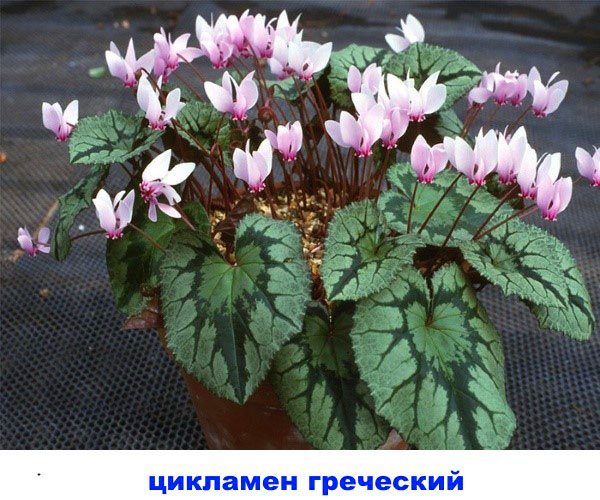

Already from the name it becomes clear that the Greek cyclamen came to us from Greece, it also grows freely on the islands of Crete, Cyprus and on the warm coast of Turkey. Depending on the specific variety, cyclamen can have both heart-shaped and simply oval leaves. They are painted in different shades of green; lighter spots with a characteristic pattern clearly appear on the surface.
Persian
Cyclamen Persian (Cyclamen persicum) is a widespread plant in some countries of Asia, Africa and Western Europe (Sudan, Ethiopia, Italy, Cyprus, Iran).
This type of cyclamen grows comfortably in countries with moderately cool winters, for example, in northern Italy, and even blooms in winter.
The plant stores many organic and mineral substances in its tuber. During the inactive phase, it feeds on these substances. In the wild, if the grubby blooms in winter, it especially needs organic matter.
Dutch breeders have developed a lot of hybrids of Persian cyclamen. Hybrids have a longer flowering period.
Kosky
In the Aegean Sea there is a certain island of Kos, after which this type of cyclamen is named. The plant is found in the mountainous and coastal regions of Bulgaria, Georgia, Lebanon, Syria, Turkey, Ukraine and Iran.
Blooms koskaya dryak in late winter or early spring. Foliage appears in late autumn and sometimes in winter.


The foliage can be green or dark silver, depending on the plant variety. The color of the flowers is different: pink, purple, red, white.
The bases of the petals are always brightly colored. This type of flower is characterized by tubers with roots that grow only from the bottom.
There are certain patterns in the size of the flowers, the change in the color of the petals and the shape of the leaves: light pink flowers and bud-shaped leaves in plants from southern Lebanon and Syria, a bright pink color of flowers is characteristic of cyclamen from the northern coast of Turkey, further to the east the leaves become narrower, and the flowers are larger.
Heart-shaped leaves with large flowers are observed in the southern regions of Iran and Azerbaijan.
What does cyclamen love and what is he afraid of?
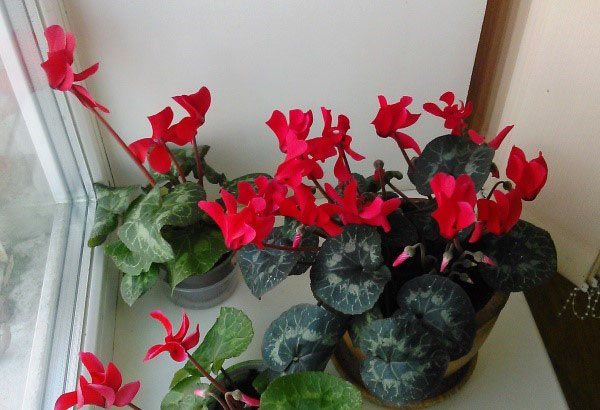

When planning to grow a plant, it should be borne in mind that it prefers:
- coolness;
- Fresh air;
- sufficiently high air humidity;
- diffused lighting.
The most comfortable temperature for a flower is up to 20 degrees Celsius, but not lower than 10 degrees. In order for it to bloom in winter, even less is needed - up to 14 degrees Celsius. Frequent ventilation allows the cyclamen to supply fresh air, especially during the heating season. You can also refresh the bush with the help of regular spraying, in addition, they will raise the humidity and lower the temperature in the room.
During the airing of the room, it is necessary to exclude the possibility of a draft - it is destructive for a flower.
Another important point in caring for a cyclamen at home concerns watering. It is best to moisten the soil in the pot with the bottom watering method, lowering the flowerpot in a bowl of water. Keep it there until the substrate is completely saturated with moisture and the top layer becomes wet. Then you should remove the cyclamen and let the excess water drain. The liquid from the pallet must be drained so that it does not stagnate.
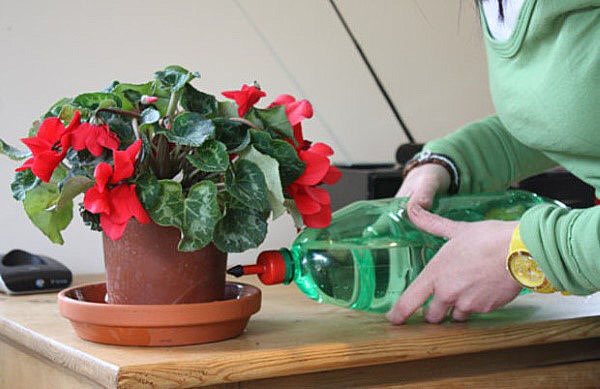

Bottom watering of the cyclamen will eliminate the possibility of moisture getting on the top of the corms, as well as directly on the flowers and leaves. If you water the bush directly into the pot, there is a risk of flooding the growing point, and this usually ends with rotting of the tuber and, accordingly, the loss of the entire plant.
Cyclamen can still be poured directly into the pan, remembering to then drain the excess water from it.
With regard to fertilization, cyclamen refers to those indoor plants that are better undernourished than overfed.
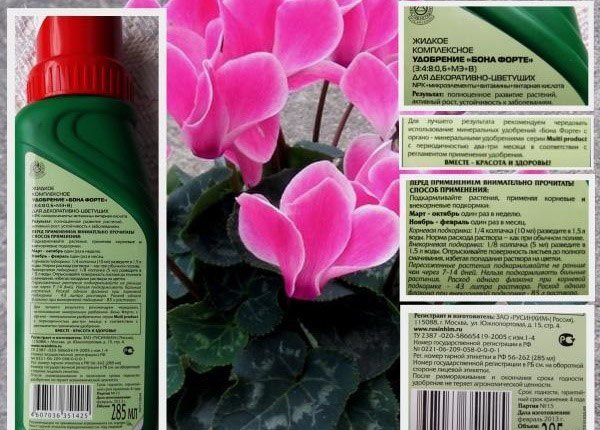

The flower responds well to complex preparations for flowering plants, especially in liquid form, but the working solution should be prepared strictly following the recommendations for its use, sometimes even reducing its concentration.
The purchased plant does not need additional fertilizing for the next 2-3 months: usually the store soil contains a large amount of nutrients, which are used to “fill” the plant so that it blooms profusely and has a beautiful “marketable” appearance.
Where does it grow in nature?
Not all wild-growing cyclamens grow in the forest. For example, the largest wild representative, Cyclamen africanum, took a fancy to the rocky terrain, hiding in bushy thickets. Its leathery leaves of bright green color are 10 cm wide and 15 cm long, but they appear when pinkish flowers bloom on a bare tuber.
Cyclamen ivy (Neapolitan) chose the habitat of the Mediterranean coast. This southern species is easily recognizable by its ivy-like grooved and serrated leaves. By the fold of the petal, it is similar to the European species, but has “horns” at the base. In September and October, it pleases with lush pink flowers.


Many species feel comfortable both on rocky ledges and among mosses and lichens, in the shade of forest trees. Flowers are most difficult to survive on wooded slopes where landslides occur, as sometimes the tubers are too deep, making germination difficult.
An example of a species that came to a house from the forest is Colchis cyclamen: it grows on the limestone slopes of subalpine forests. No wonder the genus Cyclamen is called the Alpine violet. It is also found in the south of the western Caucasus. It blooms from August to October with pink flowers with dark spots at the limb. Has a very strong aroma similar to lily of the valley.
Thanks to the ants that carry the seeds, the threat of extinction of the species is not as great as that of the Kuznetsov (Caucasian) cyclamen. But these two species are listed in the Red Book of Russia and Ukraine.


Cyclamen parviflorym (small-flowered) grows both in the rocks of Turkey and in the spruce forests of Russia. The twilight of spruce crowns, fertile leafy land, high humidity - these are the natural habitats of this species. Frosted leaves have a diameter of 15-30 mm, and the petals are even smaller. Pale lilac, pinkish, deep pink petals have a burgundy spot at the base.
There are other types of forest cyclamens. They grow both in Central Europe and in Central Asia, the Mediterranean. The Caucasus and Crimea are the area of growth of certain species, but the progenitor of cyclamen appeared in Europe. Thanks to breeders, many cultivars and hybrids have been bred, which are grown in gardens and at home. But they do not have the same aroma that is inherent in the forest species.
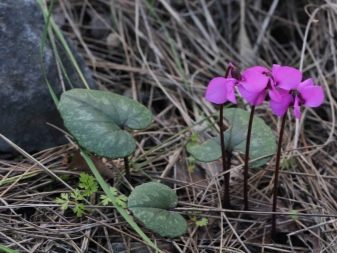

Landing
To plant cyclamen at home, you should know how to collect seeds. To collect, you need to wait until the long stalk bends in a spiral and begins to hide the fruit-box under the leaves, pressing it to the ground. At home, you need to extract the grains from it, selecting the largest ones.
Before planting, they are soaked for 15 hours in a manganese solution or for 12 hours in a growth enhancer such as "Epina" or "Zircon". During this time, it is necessary to prepare a container with a substrate for cyclamens. You can do it yourself, the main thing is that it is breathable. For this, coarse-fiber peat, leaf turf, humus, sand are used in equal proportions.
Grooves are made in the soil, moistened with a spray bottle, and seeds are scattered with an interval of 2-3 cm. Usually it is advised to cover the container with a film and put it in a cool, but bright place with a temperature not higher than 20 (or better 15) degrees.
But experienced florists recommend using a newspaper sheet instead of film. Moreover, watering must also be done through a newspaper, so the soil will retain moisture longer, and depressions and crusts will not form on the ground.


Seedlings will appear in a month, after which the film or newspaper is removed. The container is rearranged under bright diffused light, but without increasing the temperature. The plants dive after the appearance of the second pair of leaves. After 3 months, when the seedlings grow small tubers and a few leaves for themselves, they are transplanted into permanent pots (if the plant grows in the house). For this, it is imperative to use drainage.
The tubers should be planted so that the top half is above the ground. A week after planting, the young are fed with ammonium sulfate (2 g per 1 l of water), and 10-14 days later - with potassium nitrate (1 g per 1 l of water). The first year, the seedlings will grow very slowly, as the tubers are growing. But on the second they can already bloom. By this time, the flower is transplanted again, deepening by 2/3.
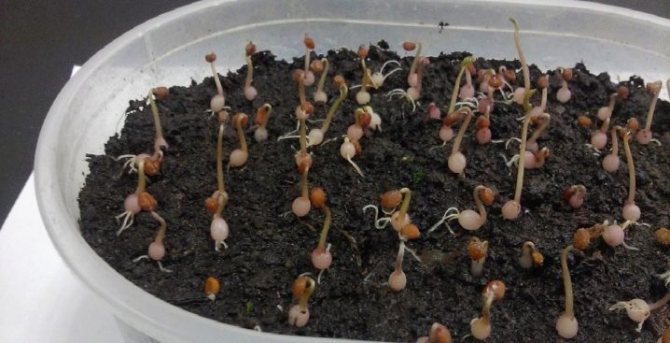

In the same way, young nodules are planted from an adult plant. But at the same time, the torn roots must be sprinkled with crushed coal. The transplant is carried out into new soil if the pot has become small.
Reproduction by dividing a tuber is a more complex process.


15-18 months after sowing the seeds, the flower blooms vigorously. And after flowering, the leaves also wither, leaving a bare tuber. This is just a dormant period, not the death of the flower.At this time, watering is significantly reduced, only moistening the ground. And the plant does not like high temperature. Experienced growers reduce room temperature by adding snow and ice to the pan.
During the period of active growth, the plant requires regular watering through the pan and humidification of the air around the flower. Cyclamen does not need dampness in a pot: it is better to water less often, but more abundantly, without moisture getting on the leaves.
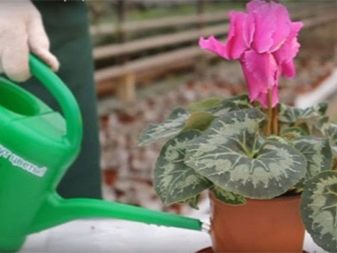

The rise in temperature is perceived by the flower as a time of rest. It is optimal to maintain a temperature of 10-19 degrees, especially during the flowering period. At the same time, the cyclamen loves good lighting - additional lighting will be required in winter. But it is important not to overheat the flower under the lamp.
Feed the plant every two weeks during the growing season, and never during the dormant period. Minimum nitrogen and more potassium and phosphorus. Since cyclamen naturally lives in deciduous soil, it will need organic fertilizers at home. therefore it is important to draw up a feeding schedule, alternating between its different types.
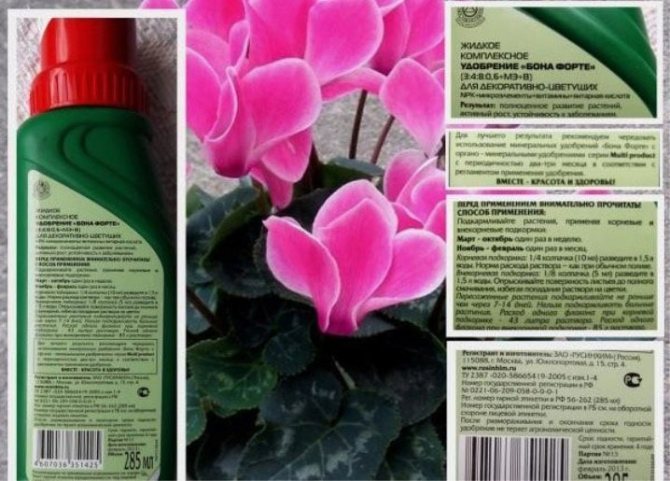

For the intricacies of growing cyclamen, see below.
Miniature Cypriot cyclamen
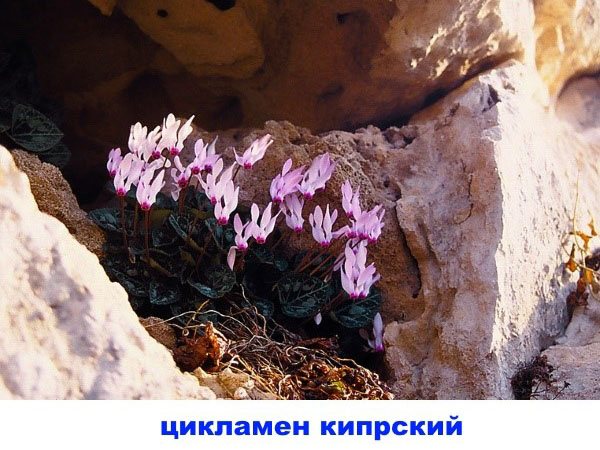

One of the most compact types of cyclamen, Cypriot, grows to a height of no more than 16 cm. Despite its modest size, it has a persistent character: in nature, the flower is able to live and develop even on stony soils, it is not for nothing that its most numerous "settlements" are found in the mountains.
Perennial "baby" and blooms very gently, white or light pink inflorescences with a darker spot at the base. The flowering period of the Cypriot cyclamen falls at the beginning of autumn and sometimes lasts until the very end of winter.
Cyclamen forest: description and cultivation
Photo by Olga Bondareva
Description:
the genus includes, according to various sources, from 15 to 55 species, distributed in the mountains, mainly along the coasts of the Mediterranean, Black and Caspian Seas. Perennial tuberous herbaceous plants that
have their own characteristics
... In 1 g up to 150 seeds.
For growing in the gardens of Central Russia
suitable cyclamens from Central Europe, the Caucasus and the Crimea. From spring flowering these are the cyclamen of Kos (C. coum) and many rare species growing in the territory of the former USSR. From autumn-flowering cyclamens for Central Russia can be recommended: reddening cyclamen, or European, alpine violet (C. purpurascens = C. europaeum), ivy-leaved cyclamen, or Neapolitan (C. hederifolium = C. neapolitanum = C. linearifolium). In the West, the decorative properties of Persian cyclamen are widely used in the garden. In autumn and early spring, it is planted in vases, hanging baskets, near the porch.
Selection of the firm "Morel Diffusion"
provides for the special resistance of plants in conditions of keeping in the air.
Location:
love warmth and sun, and a dry and sheltered location. You can plant them in the shade of deciduous trees.
The soil:
planted in a mixture of sod and leaf land with the addition of crushed limestone, crushed lime or old plaster. The plantings need good drainage, as the plants suffer from the slightest waterlogging.
Care:
in the middle lane for the winter, light shelter with leaves is necessary; shelter is not required to the south. In autumn, the soil is fertilized with high-quality compost. During summer dormancy, forest cyclamens do not need to be dried and can remain in the ground, receiving the same portion of moisture as the surrounding plants. If cyclamens are planted under trees and a fallen leaf covers them, then it can be left untouched: like all forest plants, they successfully cope with this problem, breaking through the litter with young shoots. A layer of leaves will help retain moisture and add fertile organic matter. Planting under deciduous trees and shrubs is often practiced in old European parks, where, in a milder climate than in Central Russia, cyclamens naturalize, incorporating into local plant communities, and successfully reproduce by self-sowing.
Cyclamen kuznetzoviiPhoto of Tambiev Ruslan
Reproduction:
only by seeds, their tubers do not share, no matter how much they grow. The seeds germinate very hard. The seeds of the Persian cyclamen are sown after ripening in a pot, sprinkled with earth well, since they do not sprout in the light. The pot is watered regularly to keep the soil constantly moist.You can cover crops with glass. High temperature is undesirable for germination, optimal - 15 °. 18 °. Seedlings appear in about a month. The seeds of small wild cyclamens are sown after dry storage to increase germination, that is, they are kept for 3-6 months simply in a bag, and then they are treated in the same way as with Persian ones.
In the middle lane, autumn-flowering cyclamens do not have time to form seeds. In spring flowering seeds ripen by mid-summer. You can sow them in pots in the fall, without fear of short daylight hours. Indoor cyclamens only produce seeds when artificially pollinated. Seedlings bloom for 3-4 years, when the tuber grows sufficiently.
If you buy a cyclamen tuber, pay attention to how much it weighs. The tuber should be heavy and not wrinkled. See if the tuber has buds. They are located at the top and look a little like begonia sprouts. Planting is carried out during the period of vegetative dormancy, to a depth of 5-10 cm for better protection from frost, although in the southern regions they can remain semi-buried, as in nature. They must be handled with care, without damaging the surface. juicy tubers can easily rot. If there are stems, then it is also undesirable to damage them, so as not to lose buds. Repotting can weaken the tubers, so the longer you leave them alone, the better they bloom. They can stay in one place for a very long time.
The healing properties of the flower
The mountainous and coastal regions of Southern Europe are considered the homeland of the alpine violet, it lives along the Caspian Sea, but in addition to the Mediterranean countries it is also found in the mountainous regions of Northeast Africa. This plant is remarkable for its life cycle, which is divided into two phases: vegetation and dormancy. In summer, the habitats are sweltering heat, the cyclamen "sleeps", shedding leaves and storing moisture in the tubers.
For his love of the mountain climate, the representative of the primroses family received the refined name "alpine violet", and for some reason he was nicknamed "dryakva" among the people. The habit of falling leaves, the cyclamen flower, like poinsettia, often scares the owners, so many use it like a bouquet, throwing it away after flowering. But with the right content, it will please the owner more than once, because this is a perennial plant!
Most of the species have an amazing aroma, which often becomes the final note of perfume compositions. The flower petals are like a flock of beautiful fluttering butterflies circling above the leaves. The alpine violet foliage also has a decorative value: smooth, decorated with silvery stripes, it favorably sets off bright flowers.
The cyclamen flower, more precisely, the European variety, as an ornamental plant, first interested collectors at the end of the 19th century, when spectacularly blooming species were in fashion. However, over time, other more wild and modest varieties have spread. The genus of alpine violets contains about 20 species, while two are grown in room culture: purple and Persian. By the way, some frost-resistant species may well decorate the garden. About this in the following materials. Follow the blog updates!
Persian cyclamen is the most popular type adapted to indoor conditions. The height of the plant is up to 30 cm, and the diameter of the flowers is 5 cm. It is distinguished from the purple cyclamen (otherwise - European) by its size. The second is much smaller: in height it grows twice as low, and the diameter of the flowers reaches only 3 cm.


In addition to well-known flower growers, there are other, little-studied varieties. Cyclamen intaminatum is native to Turkey and is the most compact species with small white flowers.
Cyclamen ivy grows in the European territory. In the summer, during the heat, it “goes bald”, and in September, ahead of the leaves, the first flowers appear. This species lives up to 130 years, and the tuber with age can reach 25 cm in diameter.
The Lebanese cyclamen is, as the name suggests, a native of Lebanon.It has the longest flowering. The flowers of this species are light pink with red veins, rather large, up to 3 cm long.
All varieties of alpine violets are highly germinating, therefore they are easy to grow from seeds. Thus, at a minimal cost, you can get a spectacular home collection.
The plant heals not only the soul, but also the body. All parts of the plant have been used for medicinal purposes since ancient times.
A wide range of organic acids and natural oils are part of the caustic, poisonous, but healing juice obtained from the tuber. Among other useful substances that distinguish this medicinal plant are sugary compounds, healing bitterness and flavonoids. The main active ingredient in the healing list is the biologically active alkaloid cyclamine, which is almost the same name, belonging to the group of saponins.
Preparations from the miracle flower - and above all from its root - have a strong antiseptic, anti-inflammatory, antiparasitic and antimicrobial effect, soothe. heal, regenerate.
On our window sills, mostly representatives of only two species - European and Persian - flaunt. On their basis, breeders have developed a huge variety of plant varieties that delight the eye with the grace of shape, color and aroma.
In fact, the cyclamen has much more diverse relatives - in the gardens and forests of our planet, beautiful representatives of 25 to 55 species of this noble genus bloom in the spring. No one will say more precisely - botanical scientists disagree on the classification of the plant. But they are unanimous in assessing the healing properties of cyclamen: all species have similar qualities and can be used in folk medicine.
There are a couple of points to note in this connection. Many species are not available to the general user in the literal sense of the word, since they are quite rare and grow in hard-to-reach, secluded corners of nature. Healers note that the power of cyclamen directly depends on its habitat: the farther north the plant settled, the higher and more valuable its ability to heal.
But if such an opportunity arises, prepare medicinal raw materials in a natural environment for cyclamen - in a forest glade. This is where knowledge about the species classification of this amazing plant will come in handy.
The variety of types of cyclamen and the healing properties of most of them are not fully understood. Nevertheless, the cyclamen "bouquet" is delicious. There are such types:
- Balearic - one of the smallest and most valuable in the genus cyclamen; grows only on the Balearic Islands, is a rare species;
- Alpine - a spring white flower with a strong aroma, its bulbs have long been used to treat various ailments;
- African - the tallest plant in its genus, grows in Tunisia and Algeria, the tuber is highly poisonous; little is known about the medicinal properties;
- Cilician is a lover of mountainous terrain, rarely used in folk medicine;
- Colchis aka Colchicum is a rare plant, little has been studied, nothing is known about its medicinal properties;
- Kosky is a profusely flowering ground cover plant that is actively used by landscape designers, its healing properties are highly valued;
- Cretan - a native of the island of Crete; medicinal properties have been researched, highly appreciated, but in practice they are rarely used recently;
- Cypriot pleases with its flowering from September to March, is widely used as a folk remedy;
- Graceful (Cuclamen elеgans) settles in inaccessible places, in the mountains of Azerbaijan, medicinal properties are poorly studied;
- Greek provides high-quality and effective medicinal raw materials, which are in good demand in the homeland of the plant, in Greece;
- Ivy-leaved, the second name is Neapolitan cyclamen, has weak healing properties, moreover, it is very poisonous;
- Intaminatum - the plant takes root well in unfamiliar conditions; there is no information about the practice of using in traditional medicine;
- Lebanese - a mountain resident of Lebanon, has pronounced healing qualities, which have long and successfully been used in folk medicine;
- Amazing is very beautiful, but for traditional medicine the plant is not of great interest;
- Small-flowered - a big fastidious, but very effective healer;
- Peloponnesian - the plant is unpretentious, traditional healers are attracted by the high therapeutic effectiveness of the juice of this type of bulbs;
- Persian fascinates with its luxury and variety, but has not very pronounced medicinal qualities;
- false Iberian - one of the most beautiful species; in folk medicine, local healers have long used the bulbs and flowers of the plant;
- European - perhaps the most unpretentious plant in its kind, folk healers most often use raw materials of this type for treatment;
- Wide-plated loves to settle on rocks; the bulbs are small in size, but the concentration of medicinal substances in them is very high;
- Rolfsianum is an incredibly beautiful and sophisticated flower, its useful properties have been little studied;
- Somali is a recent botanist discovery, discovered in the wild in Africa in 1986; quite poisonous.
Chemical composition
Tubers of a three-year-old plant are suitable for treatment. Their main wealth is a substance - cyclamine, which has pronounced anti-inflammatory and bactericidal properties.
Also, the plant tubers contain:
- Flavonoids, which have the property of protecting cells from the aggressive influence of pathogenic bacteria or viruses, strengthen the walls of blood vessels, and reduce the effect of allergens on the body.
- Bitterness with soothing, pain-relieving effects.
- Cyclamosin - regulates the immune system, provides cells with the necessary nutrients, helps them to remove toxins and toxins.
- Dextrose - activates many metabolic processes in cells, is a source of nutrients and energy.
We grow cyclamen at home: important nuances of planting and caring for a demanding handsome man


Among the variety of indoor plants, there are flowers that are often used as gifts. To get a pot with a beautiful flowering bush of cyclamen, violet or anthurium is doubly pleasant: such flowers cannot be compared with a bouquet, because it will quickly fade, and the bush will delight the eye for a long time, moreover, it can even give "offspring".
The pet cyclamen is a herbaceous perennial from the myrsin family with very bright and abundant flowering. Its original colorful inflorescences in the form of butterflies with raised wings proudly rise above the foliage on long legs and form a lush floral cap, which is simply impossible to pass by. And the leaves themselves, with their rounded shapes and light patterns on a dark background, are also very decorative. Due to its spectacular appearance and long (more than 3 months) flowering, cyclamen has long won its place in the hearts of home plant lovers.
Planting and caring for cyclamen only at first glance seem difficult, in fact, this flower feels quite comfortable on the windowsills and is able to decorate them with its flowering more than once. The main thing is to know some of the nuances of growing and create favorable conditions for it. How to do it correctly, we will talk about this today.
Where to buy cyclamen tubers
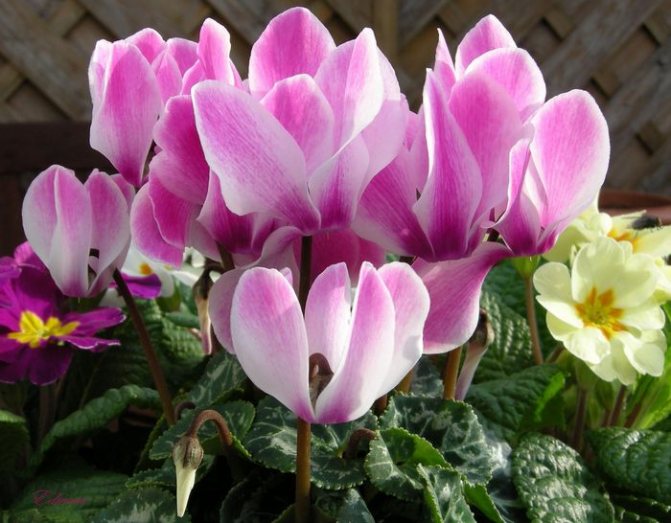

The Scientific and Production Association "Sady Rossii" has been introducing the latest achievements in the selection of vegetable, fruit, berry and ornamental crops into the wide practice of amateur gardening for 30 years. In the work of the association, the most modern technologies are used, a unique laboratory for microclonal reproduction of plants has been created.The main tasks of NPO Sady Rossii is to provide gardeners with high-quality planting material for popular varieties of various garden plants and novelties of world selection. Delivery of planting material (seeds, onions, seedlings) is carried out by Russian post. We are waiting for you for shopping: NPO "Sady Rossii"
[/ td]
Garden cyclamen
Fabulous flowering carpets under the crowns of trees are formed not only with the help of bulbous primroses, but also with other garden flowers prone to run wild. From spring to autumn, they reveal their primeval beauty and unique garden cyclamens, which are often called alpine violets. And if at the beginning and in the middle of the gardening season they simply merge into the general chorus of the first gentle colors, then in the fall they seem to be a real outlandish miracle. Winter-hardy and so similar to the legendary indoor flowers, these plants in gardens will happily settle in a secluded shade under the crowns of tall shrubs and trees, as if emitting a pink shimmer. Against the background of fallen fiery leaves covering the soil, tiny flowers with petals turned upwards on a thin peduncle seem to be an unusual mirage.
Reproduction
Persian cyclamen should be propagated with seeds. Planting is done in late February or early March, this will be the most convenient time for planting, but you can also sow seeds at any other time of the year. Before planting, be sure to treat the seeds with potassium permanganate or special preparations. Soaking is mandatory when planting this type of flowers, this is done to accelerate the growth of cyclamens.
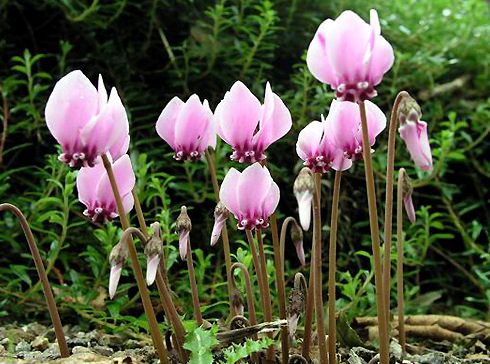

How often should you replant the plant?
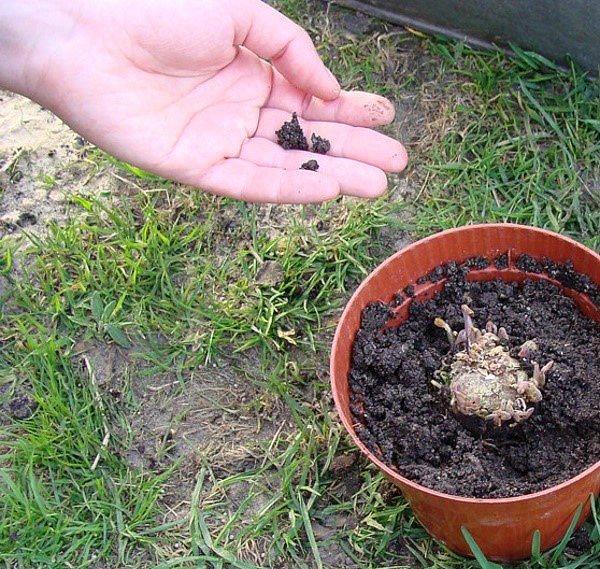

Cyclamen does not grow very quickly, and a young corm can sit in a pot for two years. During this time, it will increase the volume and it will be possible to transplant the cyclamen into a more spacious flowerpot, at the same time changing the substrate to a fresh one. It is better to transplant by the transshipment method, without completely cleaning the old soil from the tuber, so as not to damage it. The first feeding after such a procedure is done in a month.
The cyclamen should be overloaded at the end of the dormant period, until it starts to grow, while you do not need to take a very spacious container, otherwise you may not see the next flowering.
A flowering plant donated or purchased in a store (even if it is completely clear that the shipping pot is small for it) cannot be transplanted - you have to wait until it fades and dies.
Growing cyclamen in the country (video)


Cyclamen seeds should be planted in an already prepared earthen mixture to a depth of no more than 1 centimeter. You can also use peat cups when planting. First make a groove, fill it with water, place the seeds, and later cover it back with earth. The cup should be closed with a lid: this is done to achieve the optimum germination temperature of the seeds - 19 degrees Celsius. After about 35 days, you will have the first shoots, but if the cyclamen did not appear within this period, do not despair, because its seeds can germinate within 60 days (for example, Apple variety).
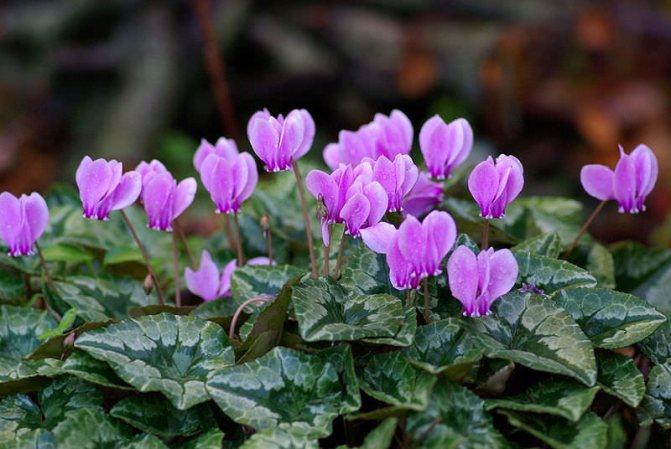

Freedom-loving alpine cyclamen
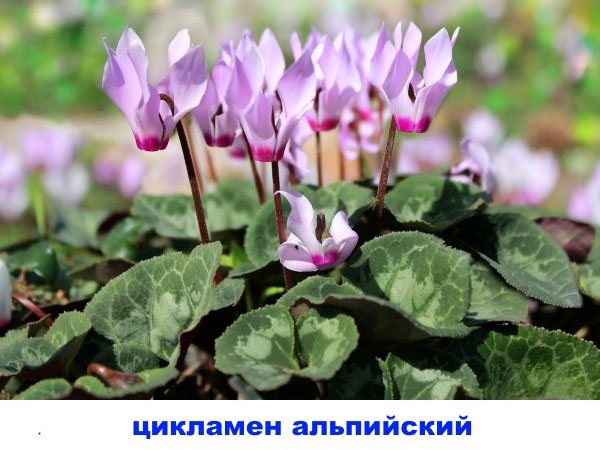

One of the wild-growing plant species is the Alpine cyclamen. For a long time it was considered extinct, but even today the flower can still be found, most often in natural conditions. The variety is characterized by the arrangement of the inflorescence petals at right angles (upright), in addition, they twist a little.
Alpine cyclamen blooms in spring, exuding a delicate honey smell, the main color of the flowers is various shades of pink. The leaf plate is oval and slightly grayish.
Problems and features
Some of the problems of growing cyclamen can surprise even experienced florists. Each of them often lies in improper care.
If the cyclamen withers, the leaves turn yellow.The problem of yellowing leaves and wilting of home cyclamen can occur for several reasons: lack or lack of moisture in the soil or air, starvation, pest damage or lack of space. How to save a cyclamen? It is necessary to transplant the plant into a large pot with completely renewed soil, to make the correct watering and complementary food, and also to make sure that all conditions for caring for the duck are met. Cyclamen also turns yellow after flowering, in this case it is considered normal.
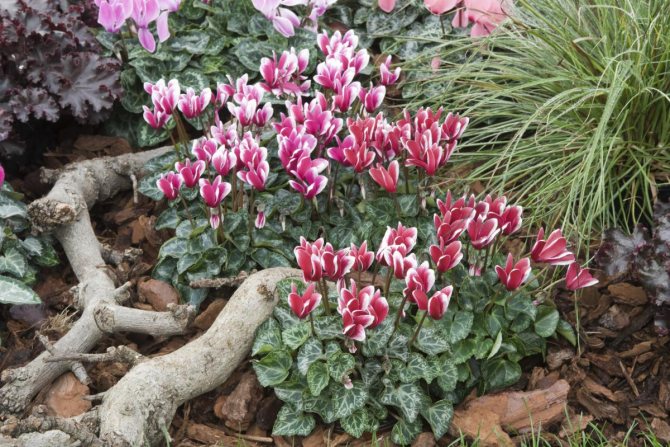

Homemade cyclamen is one of the most amazing, beautiful and unpretentious plants, which will be an excellent gift and decoration in every apartment and garden. Observing all the conditions for proper care of the alpine violet, the florist will undoubtedly be rewarded with the enchanting flowering of this plant.
General care rules
Air humidity
Cyclamen is a plant for which high humidity is important. During growth, the leaves should be sprayed. With the beginning of flowering, stop spraying. To increase the moisture readings, you need to create a water mist around the flower. To do this, put it on a pallet with wet pebbles. With the onset of winter, expose it at a great distance from the central heating batteries.
Watering
During flowering, water the plant so that the liquid does not penetrate the roots. Distribute moisture evenly to prevent overflow. But the soil should not dry out either.
Transfer
It is advisable to transplant when new leaves are formed on the plant. This falls on the end of June. For transplanting, use a low capacity, while quite wide. When performing a transplant, take into account such a moment: the root system of cyclamens is completely covered with earth. Until the roots take root thoroughly, watering is not often, and only then increase the moisture.
Top dressing
Fertilizers should be applied every 2 weeks. It is necessary to use mineral compositions provided for flowering crops. Apply fertilizer from the moment the leaves develop and continue until the plant blooms.
Diseases and pests
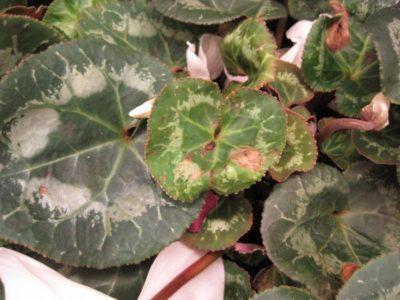

Cyclamen is very often affected by infectious diseases and pests. Most often it is attacked by a cyclamen tick. It can be detected by the presence of deformed leaves, crooked peduncles and curved buds. It is not easy to detect a tick infestation in the initial stages. With a strong lesion, drugs do not always cope with parasites, so you have to get rid of the flower.
Of the diseases, the plant is affected by gray rot and powdery mildew. These are fungal diseases. If the leaves began to curl and dry out, then an urgent need to process Fudnazol.
Cyclamen is an ornamental plant, the peculiarity of which is the ability to grow it at home and in the open field.
Does not make special requirements for the type of soil and is not picky about care.
But if you make a number of mistakes, then this is fraught with the development of diseases that can ruin the flower.
If you find an error, please select a piece of text and press Ctrl + Enter.
Cyclamen or dryakva is a perennial herb of the Mirsinovye subfamily, of the Primrose family. The homeland of the flower is considered the coast of the Mediterranean Sea, Asia Minor and Northeast Africa. Types of cyclamen have different names, which depend on the place where the flower grows. We will talk about some of them in more detail.
How does cyclamen rest?
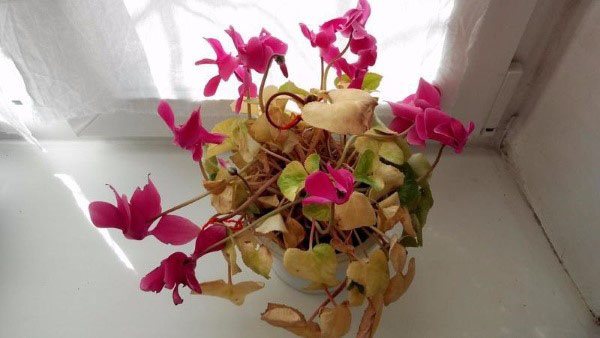

When the bush finishes its flowering and the inflorescences wither, after them the leaves begin to turn yellow, and over time, only one tuber remains in the pot. Many growers think that the plant is lost, and often even throw it away. However, this is completely in vain, because this is how the cyclamen prepares for a period of rest.
Withering leaves can be carefully removed without waiting for them to completely dry out. To do this, the petioles are simply twisted clockwise without using scissors.
Caring for a cyclamen during a rest period is simple:
- with the onset of yellowing of the foliage, they begin to reduce the frequency of watering;
- the pot with the "naked" round tuber remaining in it is moved to a more darkened place, where it will get less light, but it will not be hot;
- the dormant cyclamen is occasionally watered to prevent the soil and corms from completely drying out.
Most often, plants hibernate in winter, when the room is too warm and dry for them, because it is known that cyclamens bloom profusely only in cool and humid conditions, although the spring-summer break is also typical for them.
Flowers rest for three months. This time is quite enough for them to recover and gain strength before the next abundant flowering.
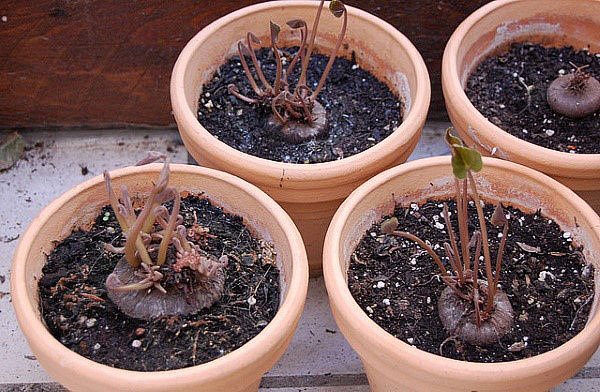

After the specified time has elapsed, the pot with corms is returned to a bright place and watering is resumed. Soon leaves will appear from the bulb, then the buds will be tied and everything will be repeated from the beginning.
Features of cyclamen
Despite the beauty and duration of flowering, and it lasts about three months, even experienced growers do not want to deal with this handsome man, believing that efforts can be wasted and the cyclamen tuber will not wake up after hibernation and will not give a dark green deciduous mass and beautiful blooming buds. Indeed, cyclamen is a very finicky flower and it is very difficult to achieve rapid and long flowering, but still possible. How to grow a cyclamen in your summer cottage will be discussed in this article.
Early flowering Kosky cyclamen


From the distant island of Koss came to us a decorative type of cyclamen with the appropriate name. Its lush bushes with rounded heart-shaped leaves produce flower stalks even in winter or early spring. The color of the inflorescences can be very diverse: from white to rich shades of pink and even red. Regardless of the basic tone, the base of the petal is always darker than the rest of the petal. The leaves themselves appear only at the end of flowering, in the fall, and the cyclamen goes to winter with them.
In the Kos cyclamen, the roots grow only in the lower part of the corm. It is painted in a very beautiful, deep brown color and has a velvety surface.
Cypriot
Cypriot cyclamen - one of the three species of plants of the Mirsinovy subfamily, which are found on the island of Cyprus. Most often observed in the mountains of Kyrenia and Troodos at an altitude of 100-1100 m above sea level.
It grows on rocky soils in bushy areas or under trees. Perennial plant, 8-16 cm high.
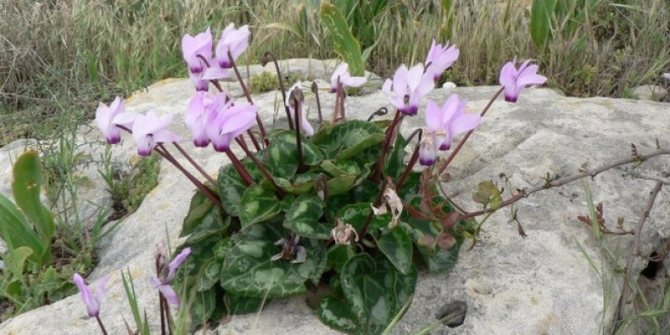

The flowers of the Cypriot dryak are pale pink or white in color with a characteristic honey aroma. Purple or purple spots are observed at the base of the petals.
The leaves are heart-shaped. The color ranges from dark green to olive. Cypriot cyclamen blooms from late September to mid-late winter. This flower is the symbol of Cyprus. It is grown as an ornamental plant in many countries of the world.
Cyclamens - Bulbous and tuberous - Garden decorative - Green-Catalog - flora-green
There are two main types of winter-hardy cyclamens - summer and autumn alpine violets. Summer
- This is Cyclamen purple, which blooms from July to early September. Autumn - Neapolitan cyclamen, or ivy, whose leaves are decorated with a silvery pattern; it blooms only in autumn.
Ivy cyclamen freezes out, but completely renews itself by self-sowing, due to which several mutated white plants often appear next to the classic pink-flowering flowers. The leaves of this type of cyclamen are the most spectacular, patterned, with several stripes and zones and an openwork edge.
In regions with less severe winters, Cyclamen Kos can also be grown, which blooms in February with sufficient shade. It is characterized by bright carmine flowers that create color spots. Most often it is planted near the house.Cyclamen koskiy is the earliest species, which also boasts many varieties with a different color.
Garden cyclamens prefer to grow in partial shade, protected from drafts and wind, like crocuses. The soil for growing alpine violets must necessarily be calcareous and enriched with humus.
Garden cyclamens gradually grow, multiplying independently and forming colorful meadows. But this, of course, takes time. The easiest way to "quickly" increase the planting of alpine violets is to grow new plants from seeds. To do this, in any container or
add nutrient soil for seedlings, level, sprinkle the seeds over it in a thin layer and cover the top with soil no thicker than 1 cm.Place the box or pot with seeds in such a room so that the ripening temperature is stable - about 18 ° C. Water the seeds from a watering can with a spray. After the shoots appear, wait for the first pair of leaves to fully develop, and then dive each plant into a separate container.
Cyclamens grow both in the shade of shrubs and trees, and among large stones in rockeries. Also garden cyclamens can be used on classic rocky slides. Cyclamens look best when planted in large tracts, especially when combined with protruding roots of large trees and stones.
From plants similar in form of growth, cyclamens can be planted with crocuses, snowdrops and crocuses; They also look good with species of primrose that are not prone to space capture. They go well with ivy, gentian and groundwort. All types of cyclamen can be grown as a pot culture.
To decorate the garden, you can use not only cyclamen growing in the open field, but also large-flowered "indoor" varieties of Persian Cyclamen, which love cold air. They can be set up in sheltered terraces and balconies at the end of summer and left there until the temperature drops to freezing.
Seat selection
Penumbra or shade. All types of cyclamen grow best in partial shade. Only Cyclamen cilicium prefers sunnier areas. Water-permeable, loose and humus-rich soil. Add algal limestone to acidic soil.
Advice
Cyclamen flowers are sensitive to recurrent spring and early autumn frosts. Therefore, in case of a cold snap, cover them with foil. Do not plant cyclamens near tall annuals or herbaceous perennials. Gardener's calendar
The end of the summer. Planting and leaving
Plant tubers of spring-flowering species in the ground in late summer or early autumn. Flowering species are watered in drought.
Spring. Planting and feeding
Plant tubers of autumn-flowering species outdoors in May as soon as they become available. Spread compost around the established plants annually, this will enrich the soil with organic matter.
The end of autumn. Preparing for winter
Most species are not hardy. They all need winter protection. Mulch the plants with leaves or spruce branches. Cover flowering species at night with plastic.
Ambulance
Cyclamens can be affected by gray mold First, spots appear on the flowers, then they are covered with a shaggy mold. Leaves and shoots of plants are also covered with brown spots and mold. Remove rotten parts.
Unforgettable flowers
Heart-shaped leaves and unusual flowers - these are the characteristic features of cyclamens.
Colors and varieties
All types of cyclamens (alpine violets, or dryaks) grown in gardens are very similar to each other. The name of this plant comes from the Greek word kyklos - a circle, it has thick rounded tubers. Leaves are dark green, basal, long-petiolate, heart-shaped. On the upper side of the leaves, as a rule, there is a white border, streaks or stripes.
The underside is often burgundy red.In some cases, cyclamen leaves are as decorative as flowers. Different types and varieties can be distinguished by the color of the leaves. Flowers of an interesting shape, with petals bent back. They can be white, pink or carmine red.
Depending on the flowering period, spring and autumn flowering cyclamens are distinguished. Spring flowering species. One of the most popular species is the Caucasian cyclamen (Cyclamen coum subsp. Caucasium), which blooms in early spring in thawed patches among the snow, covering the leaves with delicate pink-lilac flowers.
Despite the fact that this is a rather frost-resistant species, its flowers can hardly tolerate recurrent frosts. Another spring-flowering species is the wide-lined cyclamen (Cyclamen repandum) with marble leaves. It blooms from April with red, pink or white flowers. Autumn blooming species. This is, first of all, the ivy-leaved cyclamen, or Neapolitan (Cyclamen hederifolium, Cyclamen neapolitanum), blooming from September with white, pink and red flowers, on the leaves a marble pattern. Other species are Cyclamen cilicium and Cyclamen mirabile, both of which are very sensitive to frost.
Using
During the flowering period, cyclamens need moist soil. The landing site must be protected from the wind. Give the cyclamen a semi-shaded spot under trees or bushes. Cyclamens will also find suitable conditions for growing on a shady flowerbed near the wall of the house. Their beautiful leaves and unusual flowers will add additional accents to the flower bed.
Partners
It is recommended to plant cyclamens in large groups, then their delicate flowers will make an indelible impression. Spring flowering species can be combined with bulbous plants such as crocuses, snowdrops or anemone. Grow them under evergreens such as yams, yews, rhododendrons, holly or conifers.
Planting and leaving
You will need: tubers, shovel, gravel, compost, organic fertilizer, lime
1. Depending on the type, cyclamens are planted in May or August / September. Dig a planting hole 20 cm deep.
2. Loosen the soil at the bottom of the planting hole. Pour a 5 cm layer of fine gravel into it to drain.
3. Put some soil mixed with compost and fertilizer into the planting hole. Add lime to acidic soil.
4. Plant tubers in groups of 3-5, position them with their roots down at a depth of 5-10 cm and a distance of 10 cm from each other.
5. Cover the hole with earth and water. Tubers that have risen up as a result of freezing of the soil, cover them with earth again.
Valuable advice
Cyclamens do not need special feeding. Feed them compost in the spring. Spread it around the plants.
Magazine "Garden of my dreams", No. 18, May 12, 2008
flora-green.
Popular varieties
Indoor cyclamen flowers are very interesting, and a variety of varieties allows you to choose the most suitable option for growing at home.
| Flower type | Variety name | Description of the plant |
| Varieties with simple flowers | "Aurora" | Deep pink color, flowers with a pronounced aroma |
| "Aneli" | White color with a dark pink base and a pronounced aroma of flowers | |
| "Harlequin" | Whitish-pink color with a crimson base flowers | |
| "Assol" | Relatively large size, characteristic scarlet coloring of flowers | |
| "Barbarossa" | Large size, original red-white color, flowers with a strong aroma. | |
| "Mark" | Purple-pink flowers with a reddish-purple center | |
| "Caliph" | Very large, flowers with silvery salmon petals | |
| "Striata" | Large size, original lilac-white color, flowers with a strong aroma | |
| "Charlie" | Relatively medium-sized, snow-white and very fragrant flowers | |
| Series of varieties of mini cyclamens | "SilverHeart" | Leaves with eyes and a silvery heart in the central part. The height of the above-ground part is no more than 25 cm.The flowers are white, pink, red, lilac or burgundy |
| "Winfall" | Plants with nine flower colors and a uniform compact leaf rosette | |
| "Miracle" | Equal-sized aerial part with a very fragrant bouquet bloom | |
| "Silverado" | The series is presented in four colors and silvery foliage with a dark green central part and bright, prominent central veins. | |
| Varieties with simple flowers and fringed edges | "Victoria" | White petals with a crimson center and double crimson edging |
| "Red partisan" | Salmon red petals with fringed edges | |
| "Lulu" | light purple petals with fringed edges. | |
| "Louise" | Large size, attractive fringed inflorescences, with bent dark salmon petals | |
| "Moon" | Light pink petals with characteristic fringed edges | |
| Varieties with double-fringed flowers | "Rococo Leela" | Large size, fringed and terry inflorescences of an attractive lilac color |
| "Rococo-Pink" | Large and fringed, double type, pink inflorescences |
One of the most spectacular types is Pseudibericum with large flowers of bright purple or lilac-purple color. The specific feature is represented by the presence of a chocolate-purple spot at the base of the petals. The foliage is wide, heart-shaped, glossy, dark green in color with a pleasant, but not very pronounced, grayish-green tint.
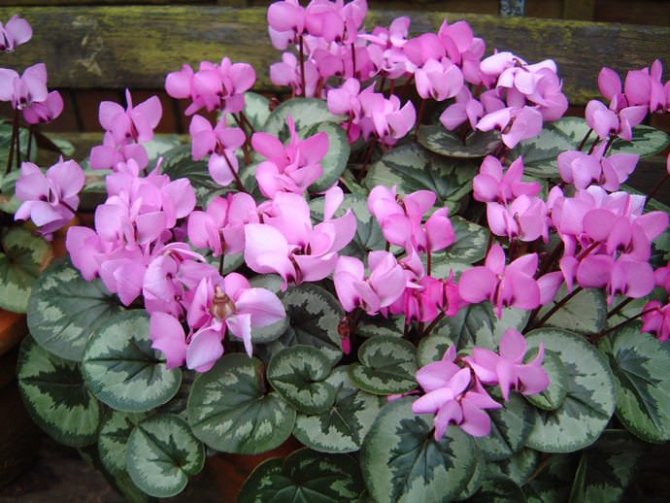

The healing properties of the flower
The healing properties of cyclamen have been known since the 3rd century BC. Today it is used in the treatment of sinusitis, rhinitis and sinusitis in both acute and chronic forms.
Active substances of the plant:
- Reduces swelling of the respiratory tract mucosa.
- They help to reduce the viscosity of phlegm and pus and thus facilitate their excretion.
- Stimulates the process of cleansing the nasal passages. That is why instillation of drops often causes sneezing and increased mucus discharge.
- They help the damaged mucous membrane to recover faster.
Where to plant cyclamen
Different types and varieties of cyclamen delight the whole season. Flower-strewn carpets grow in front of the hedges and under the bushes. Pink-red and sometimes white flowers spread a wonderful scent of lilies of the valley. The ideal decoration of gloomy winter days in places with mild winters is the Kosky cyclamen, whose carmine-red flowers open in February. It needs to be planted in September closer to home in order to enjoy the wonderful beauty, looking out of the window.
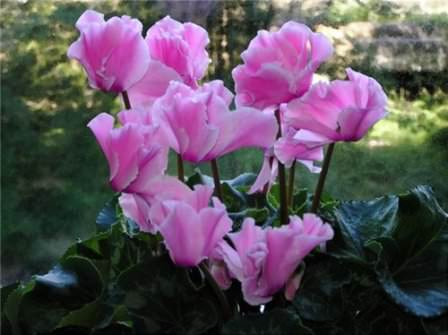

Indoor cyclamen varieties are also suitable for decorating a terrace or balcony at the end of summer and autumn.
When and how to transplant cyclamen?
Homemade cyclamen does not tolerate transplantation, so the longer the plant is in one place, the more abundant and more often it blooms. The transplant is done for only a few reasons:
- the plant is cramped, the tuber has filled the entire space;
- it is necessary to replace the soil with a new one;
- cyclamen is defeated by diseases, pests have started in the soil.
Without special need, you should not "pull out" the grubby from the already familiar environment. But if a transplant becomes necessary, it is important to do it very carefully and correctly.
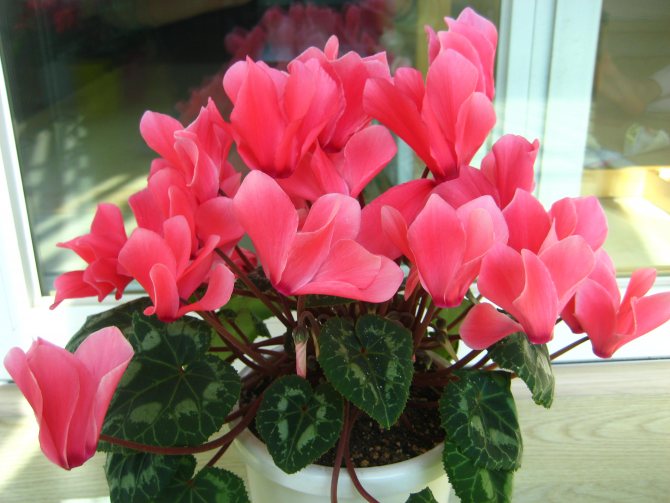

Transplantation of home cyclamen is carried out only after the plant has bloomed, closer to the state of coming out of "hibernation". You can not transplant cyclamen more than two to three times a year.
Homemade cyclamen does not like large and very spacious pots. The new one should not be especially larger than the previous one, the edges should not be further than 2-5 cm from the bulb.
This plant loves loose soils, so you should pay attention to the soil. It is recommended to spill it with a weak solution of potassium permanganate or steam it. You can buy a special ready-made soil for cyclamen, or you can prepare it yourself. To do this, take soil and organic matter (leafy earth, humus, coconut fiber, etc., as well as coarse sand) in a 1: 1 ratio.A drainage layer is placed on the bottom of the pot, consisting of expanded clay, crushed stone, granite, pebbles, etc.
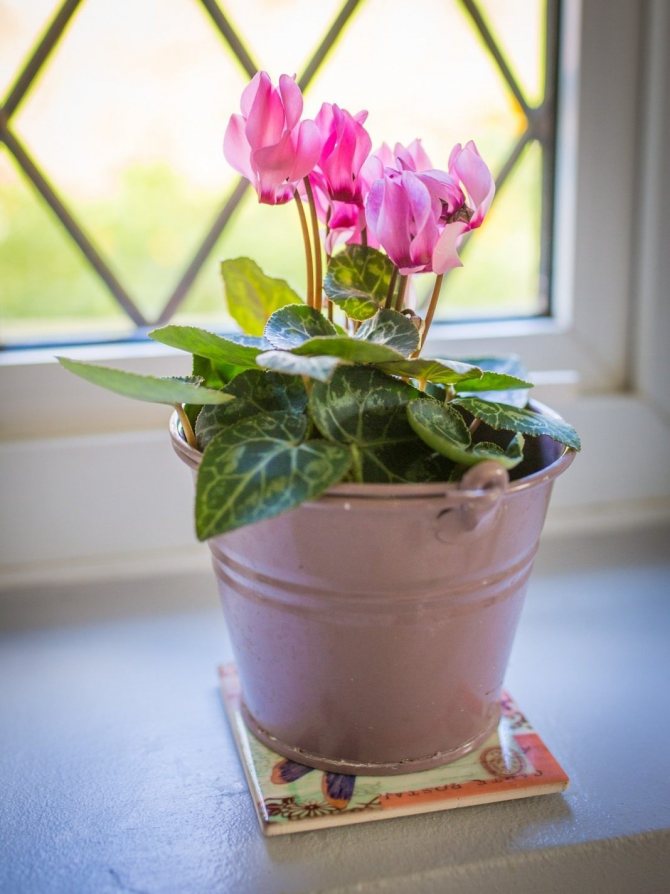

It must be remembered that in no case should you bury the tuber. On the surface of the earthen mixture, there should be a third or half of it. It is very important to observe the temperature regime, air humidity and regular watering after transplanting.

